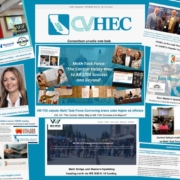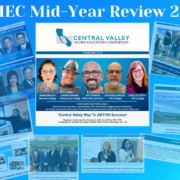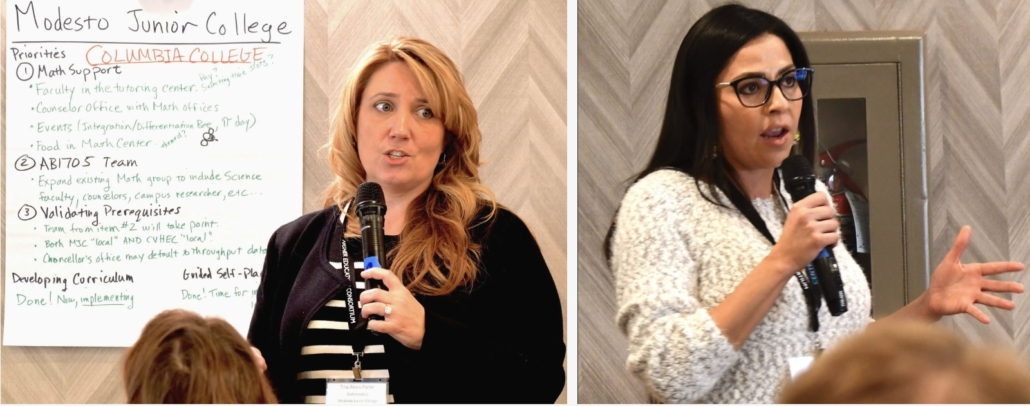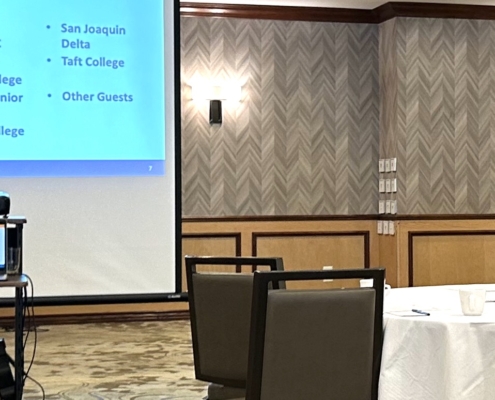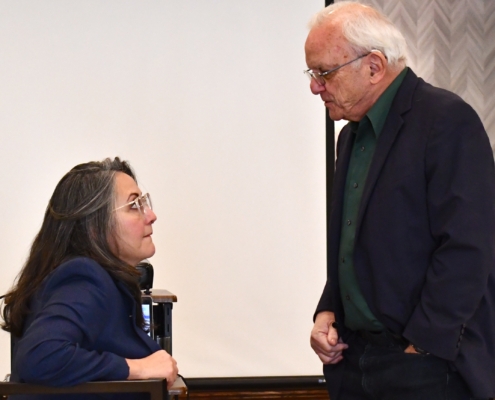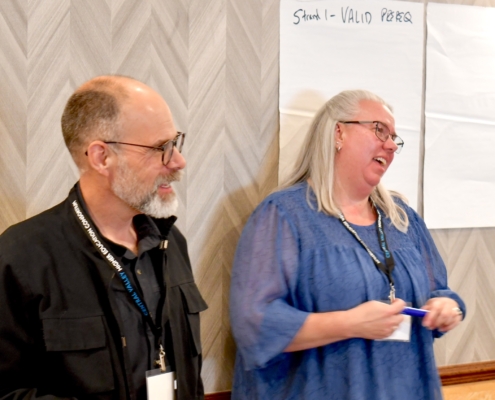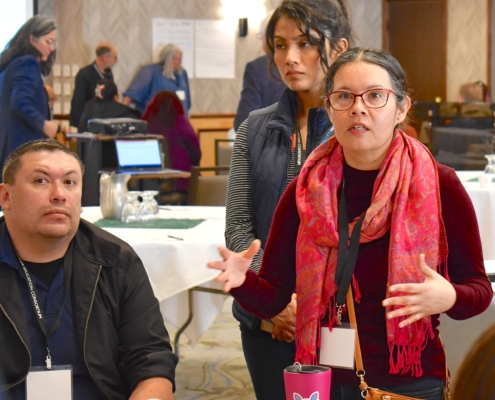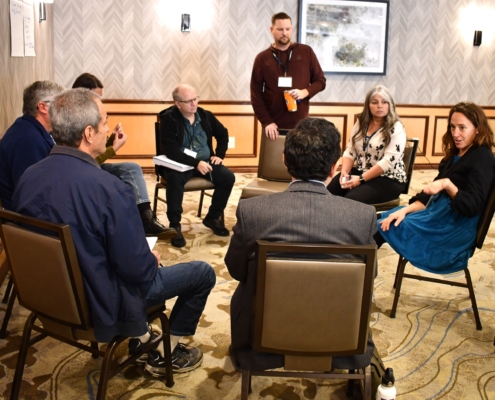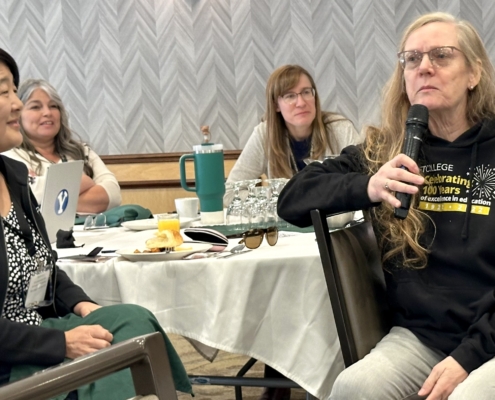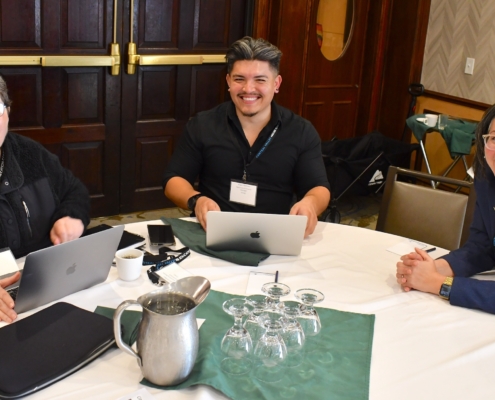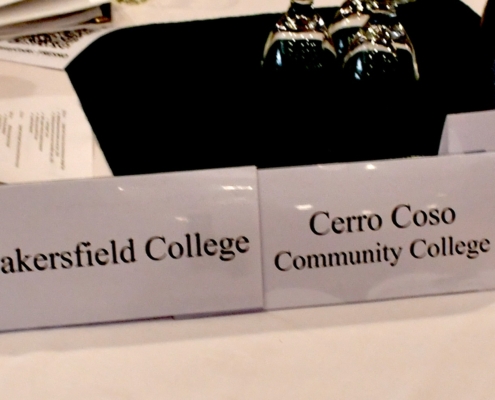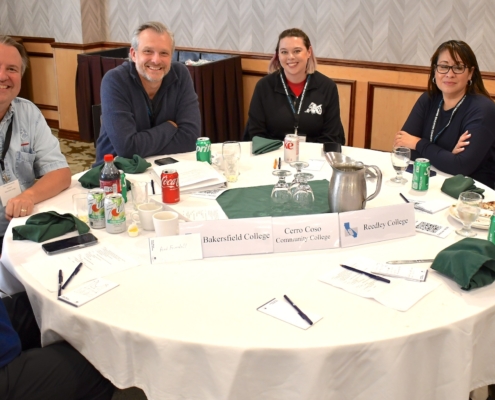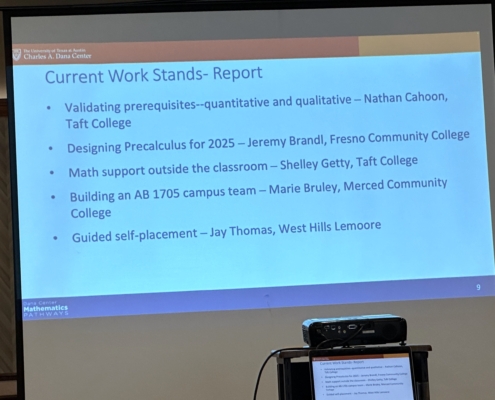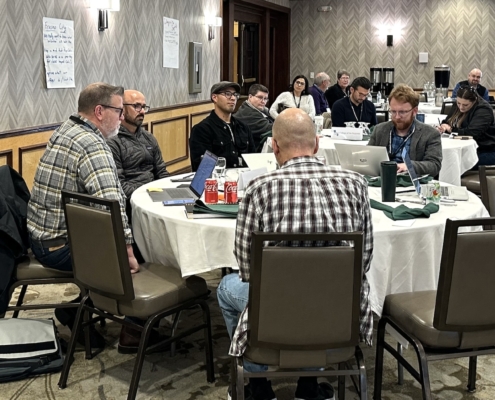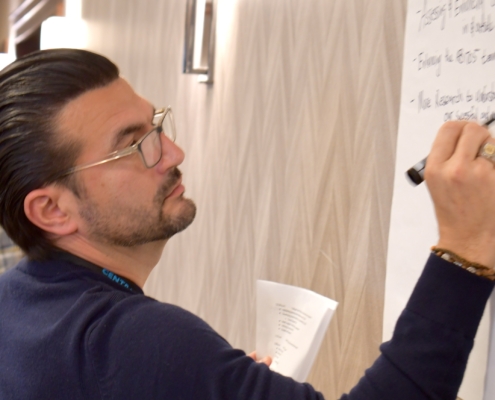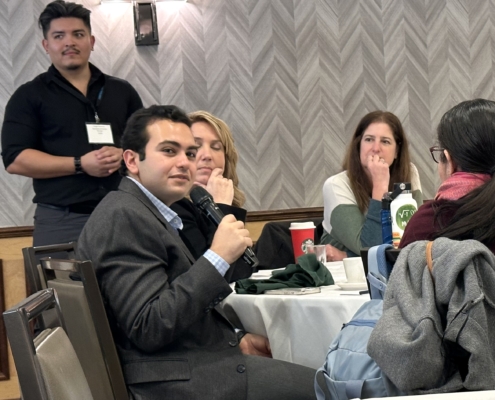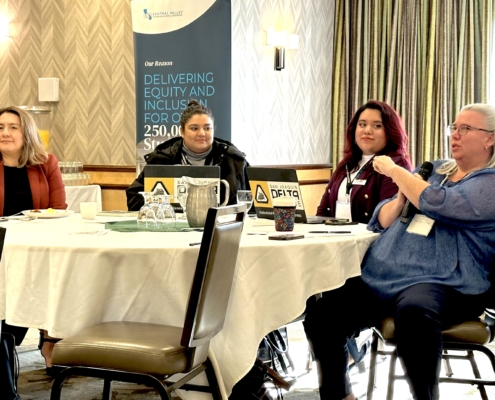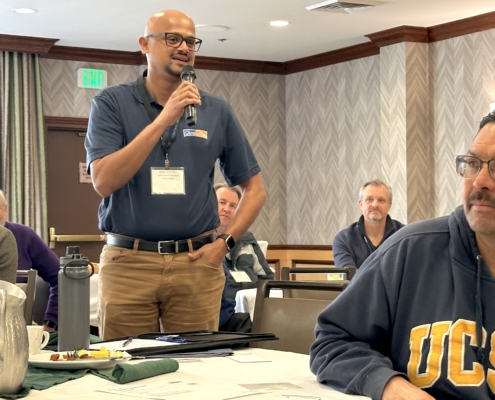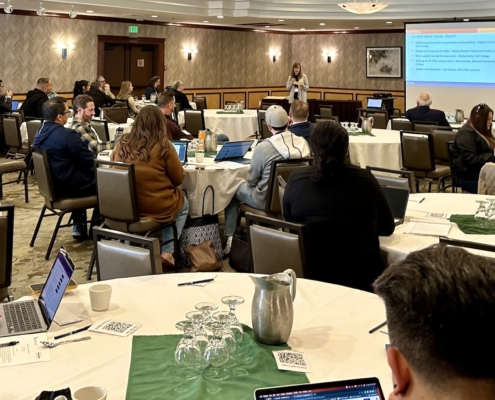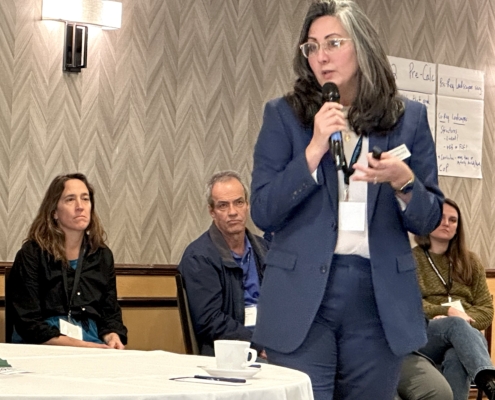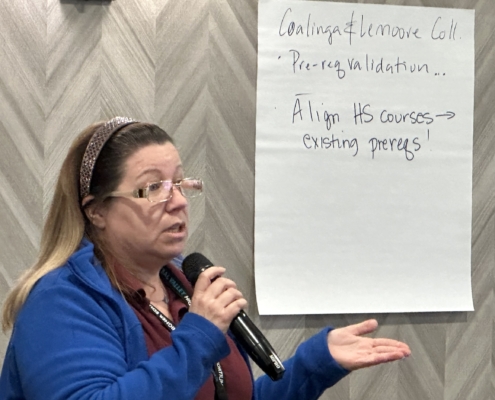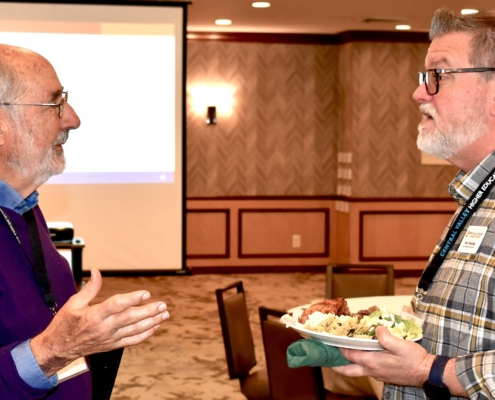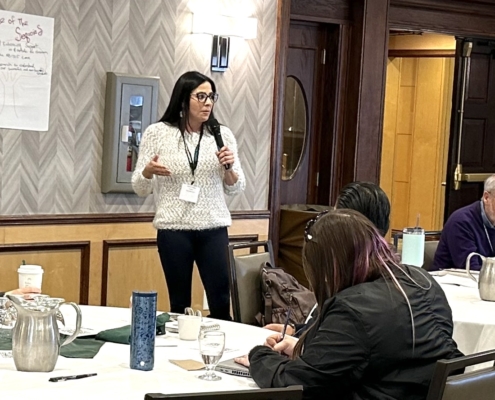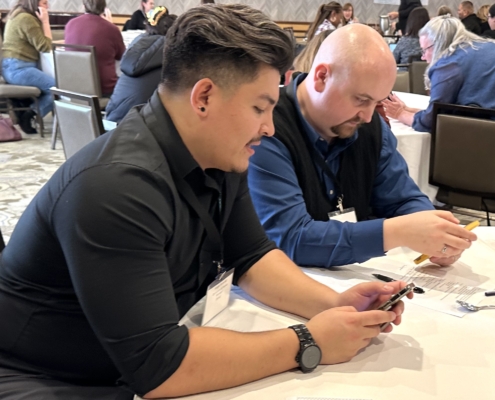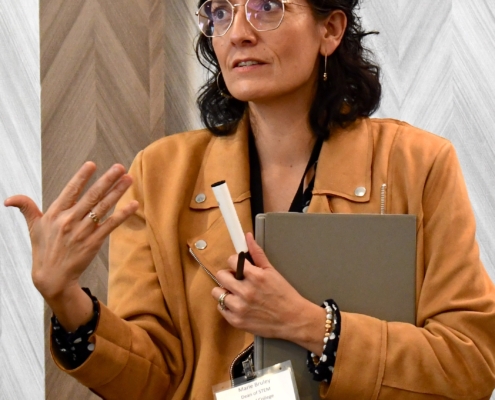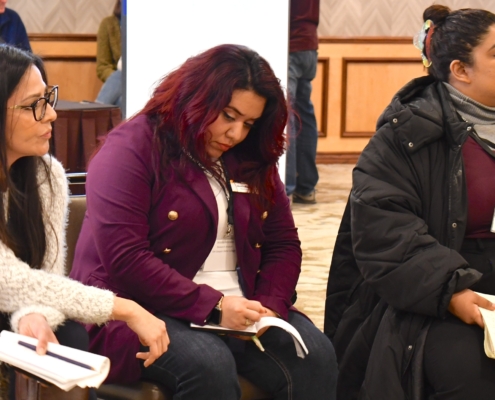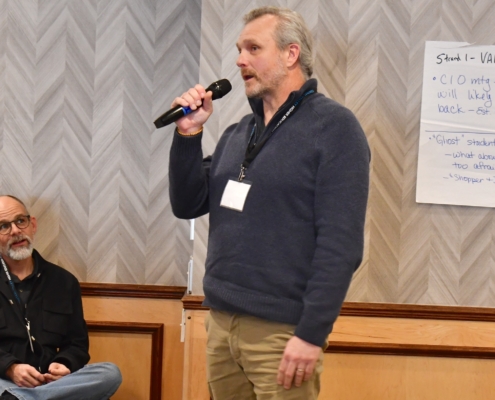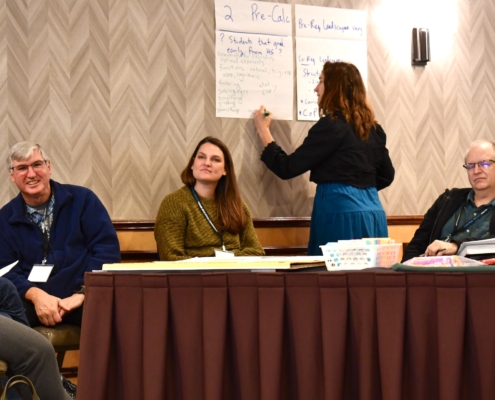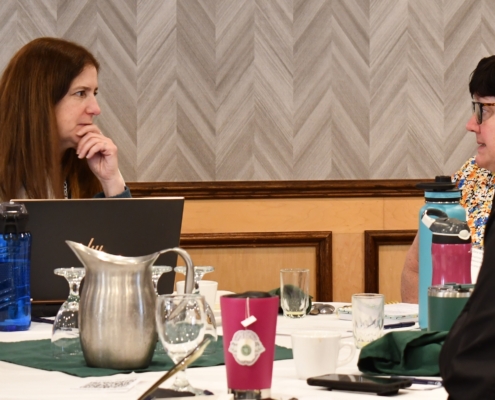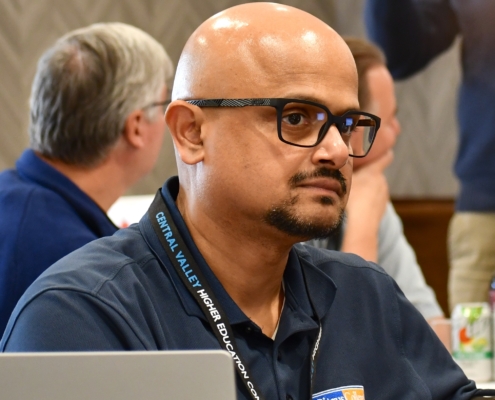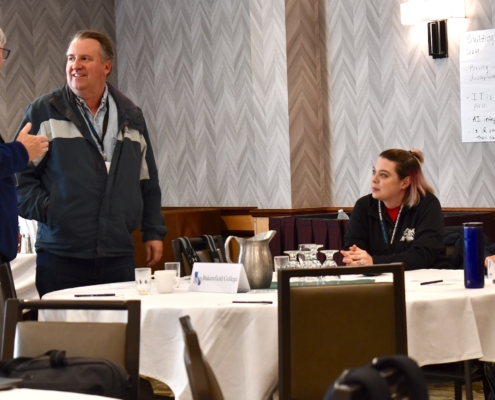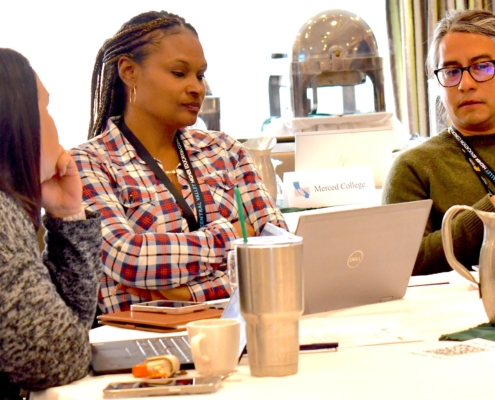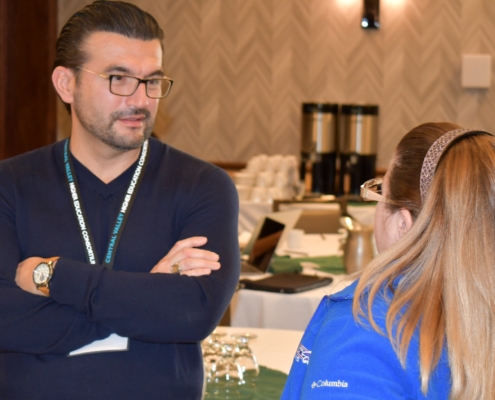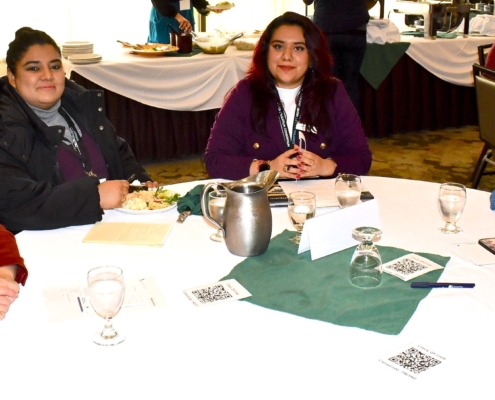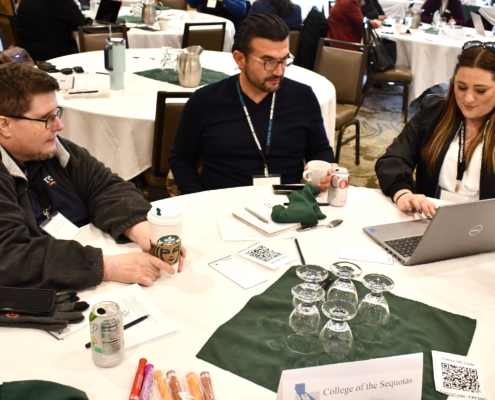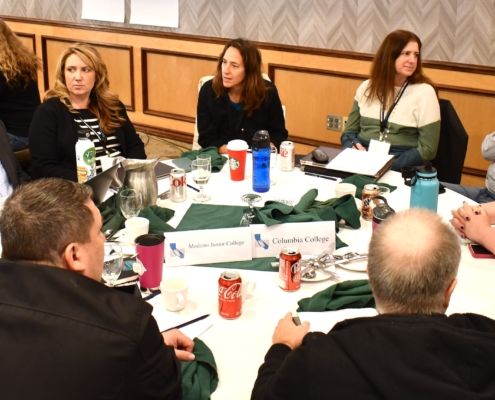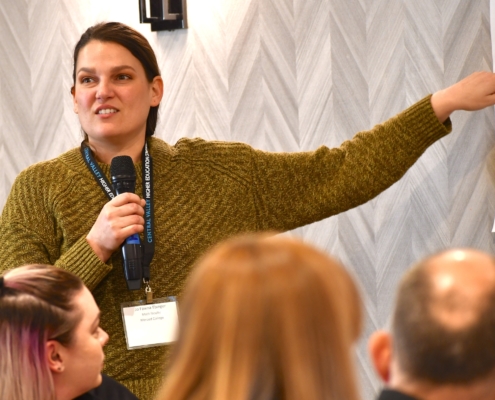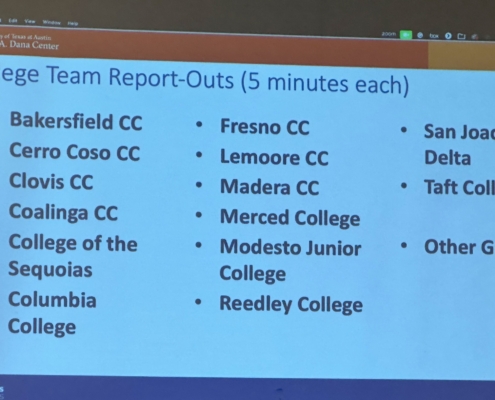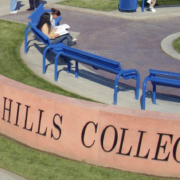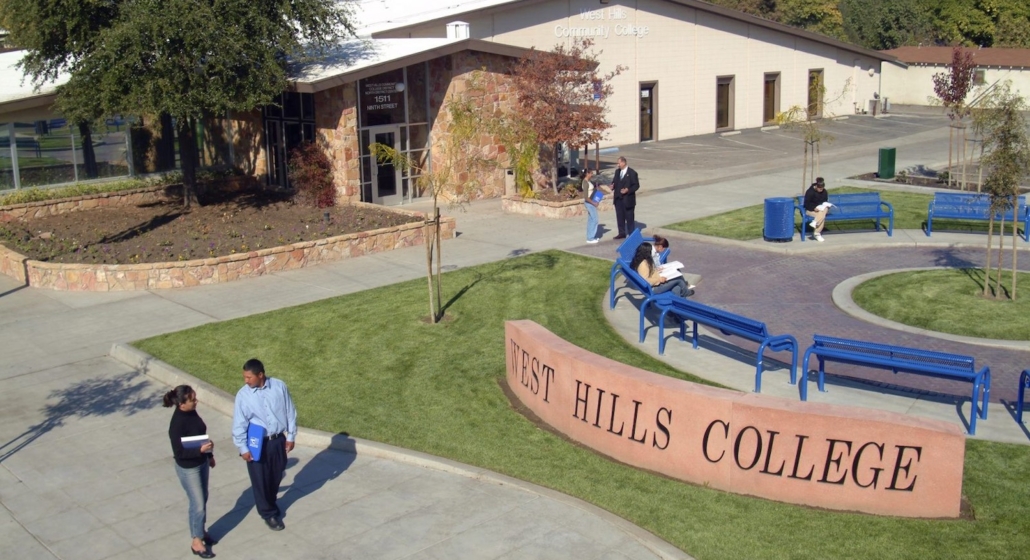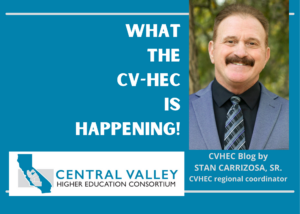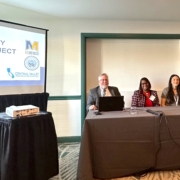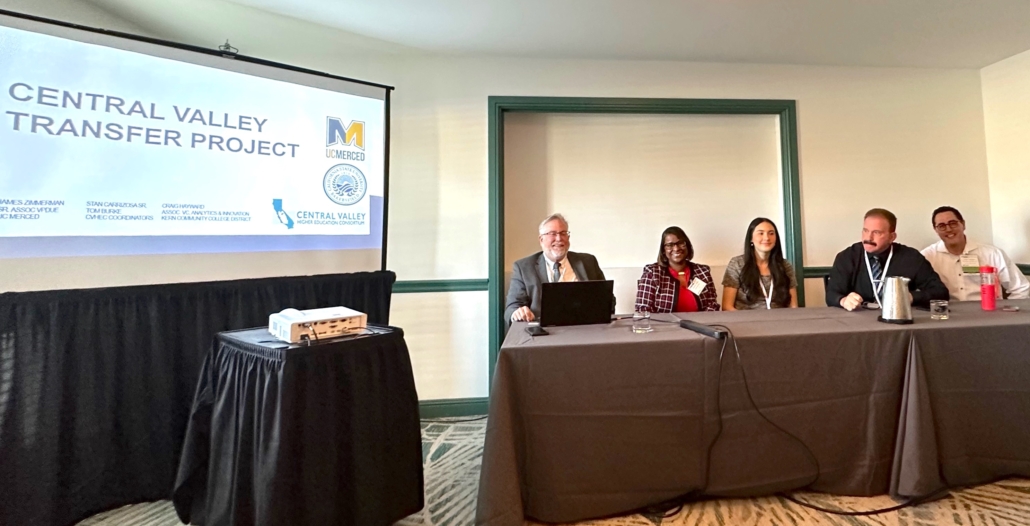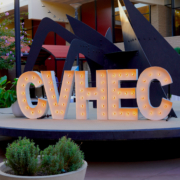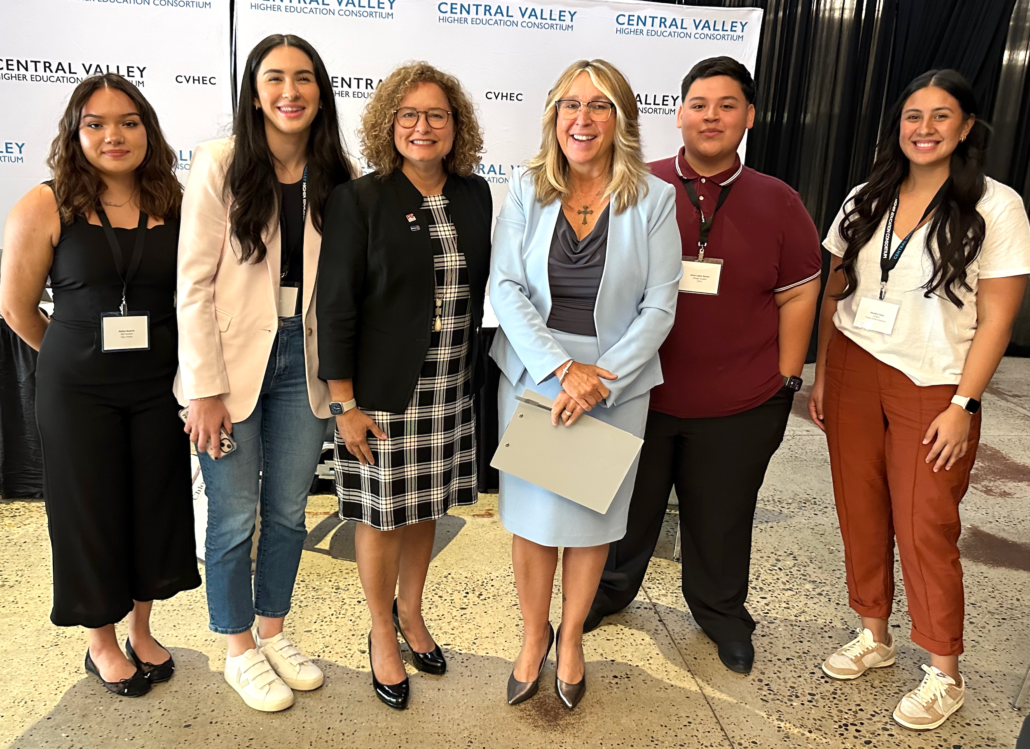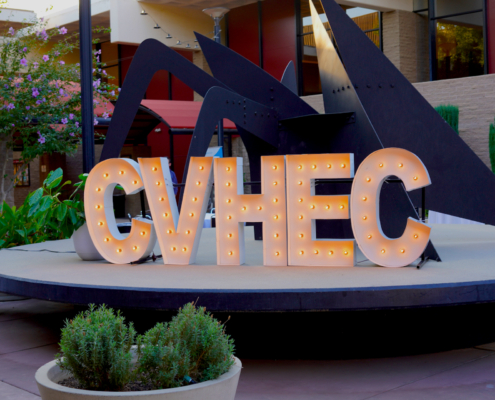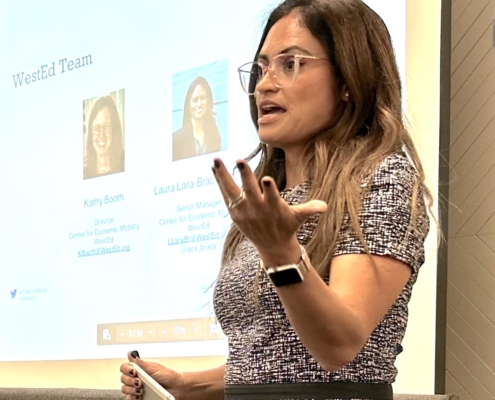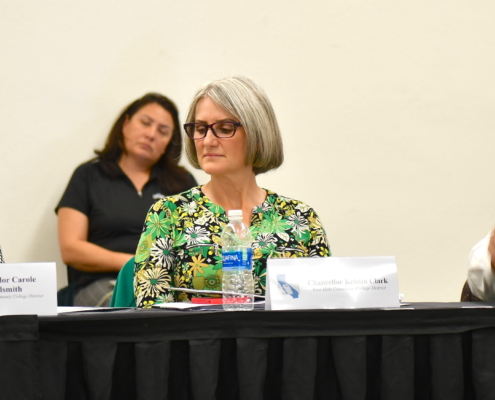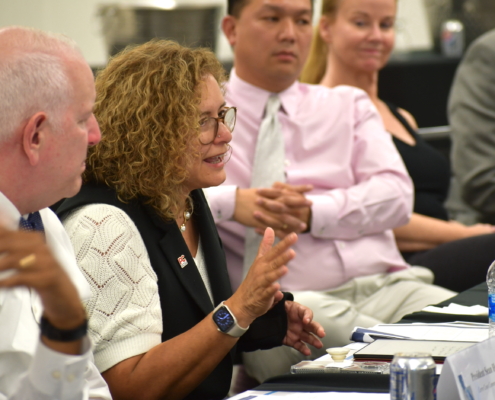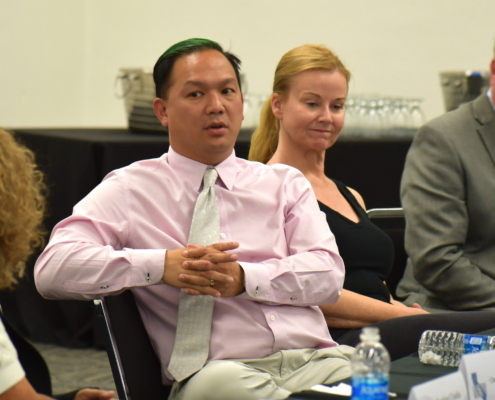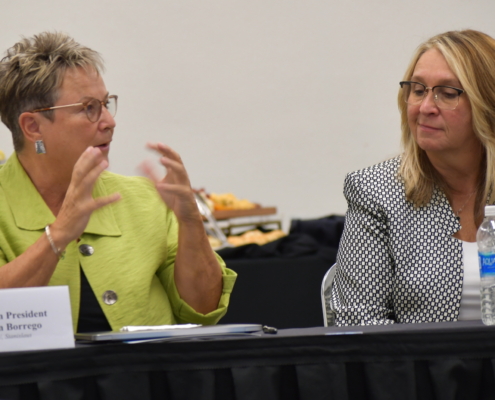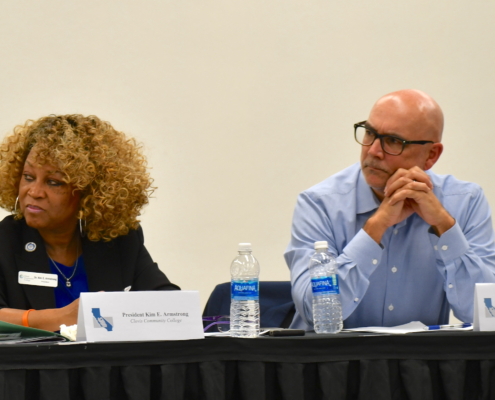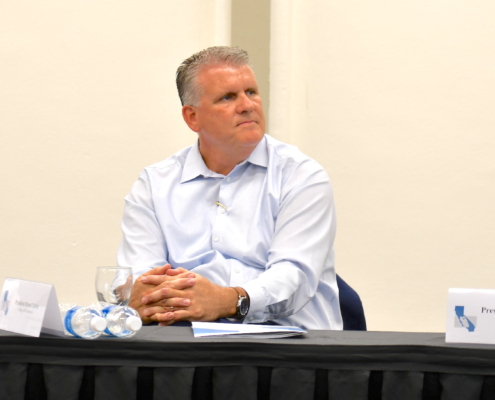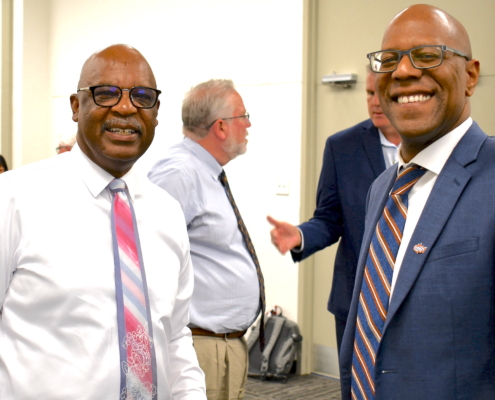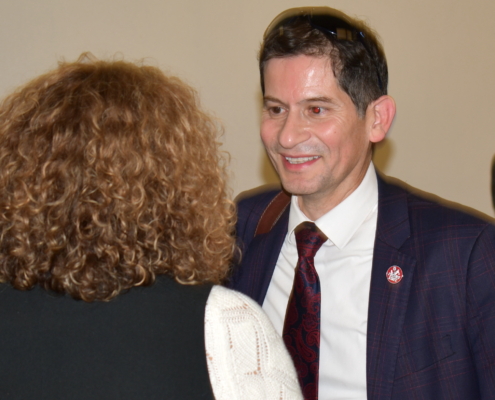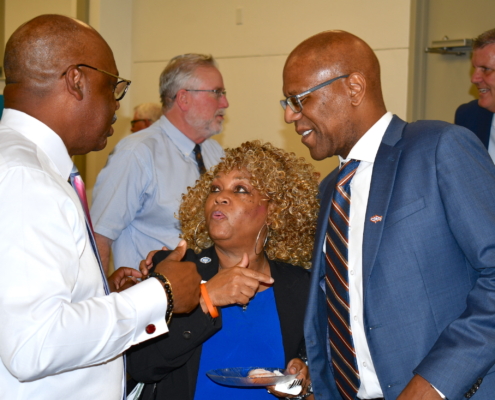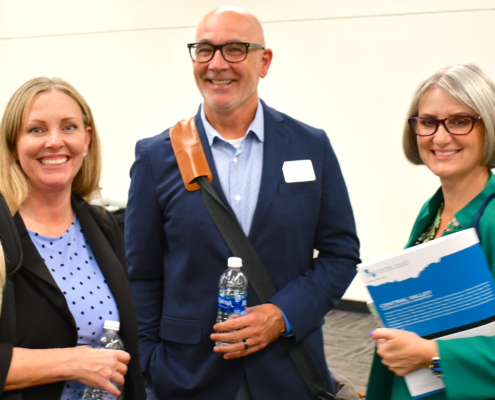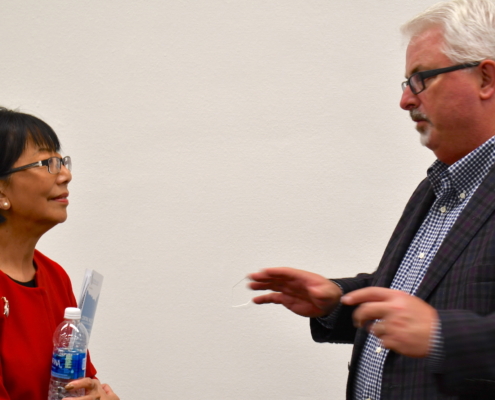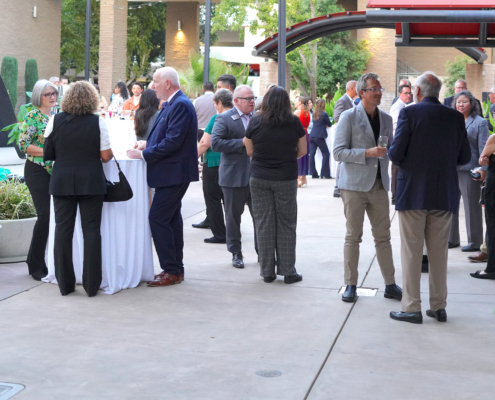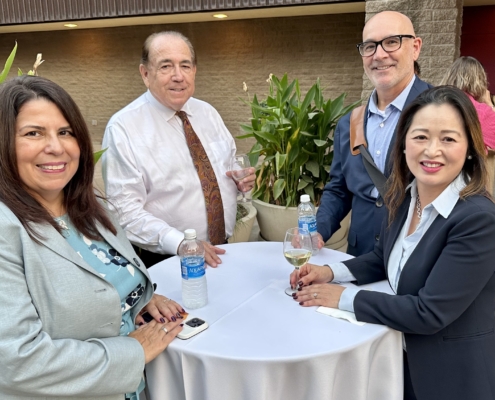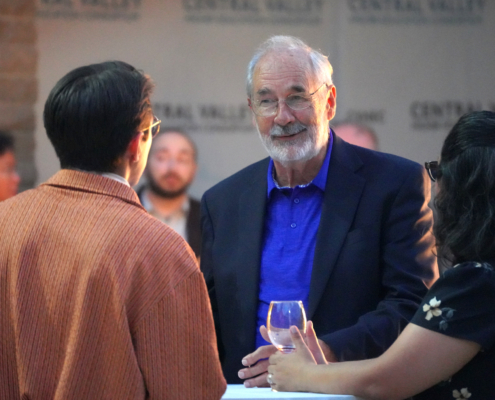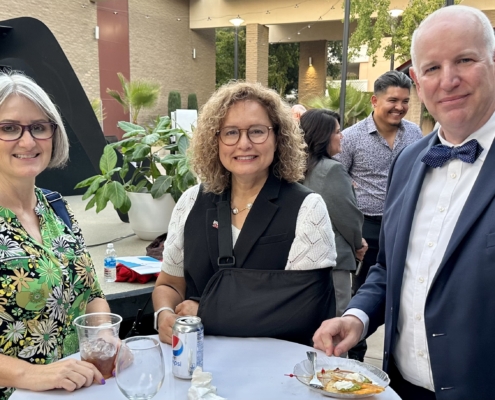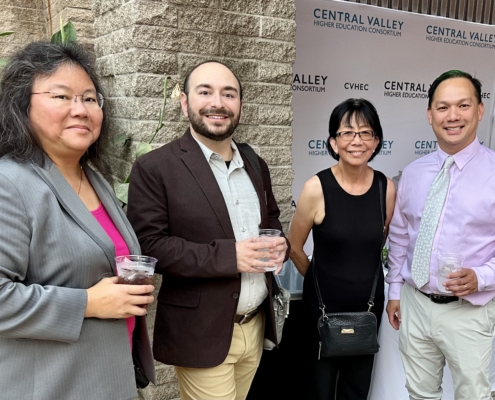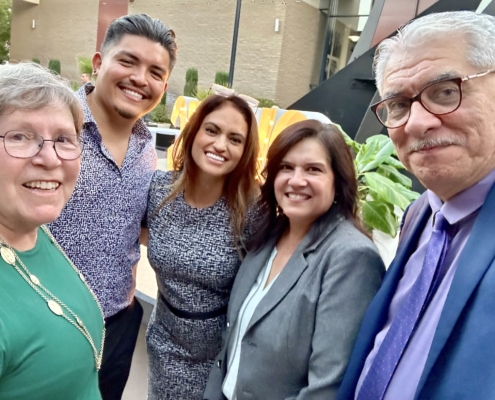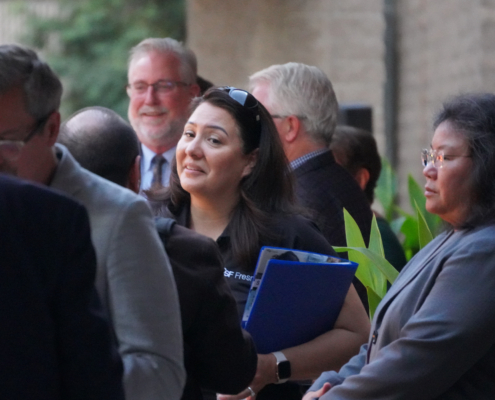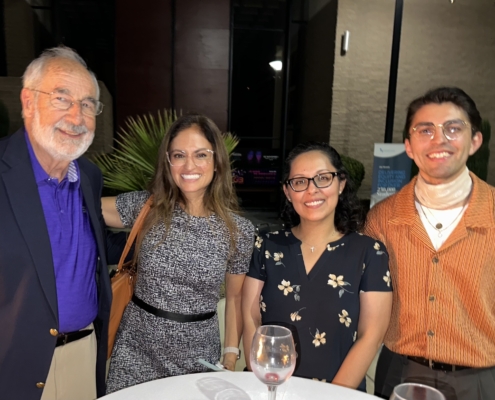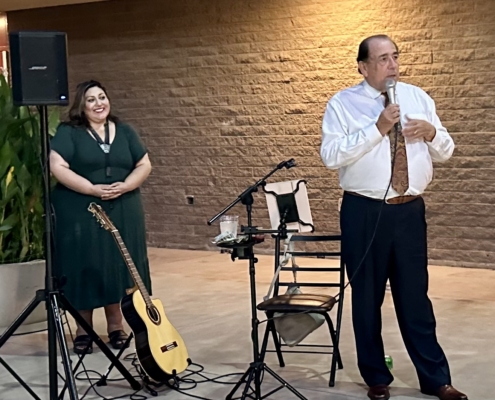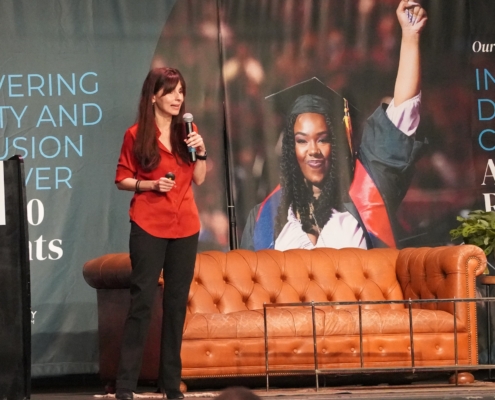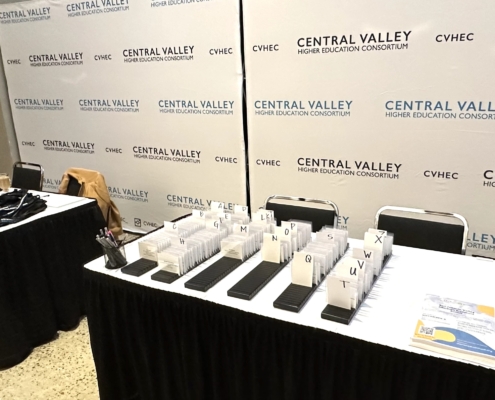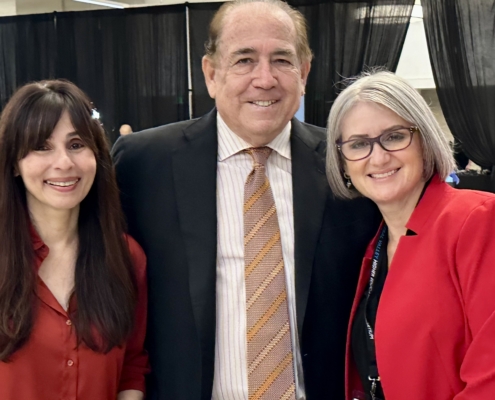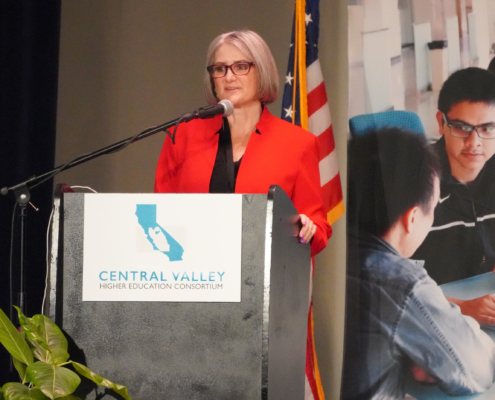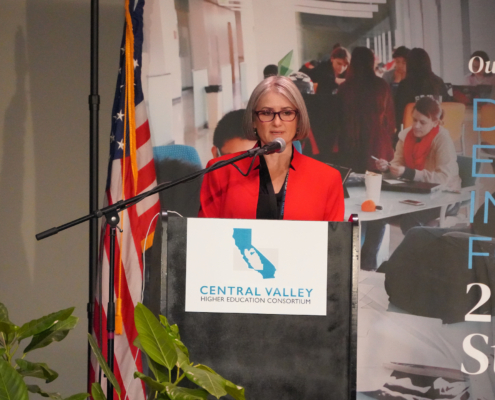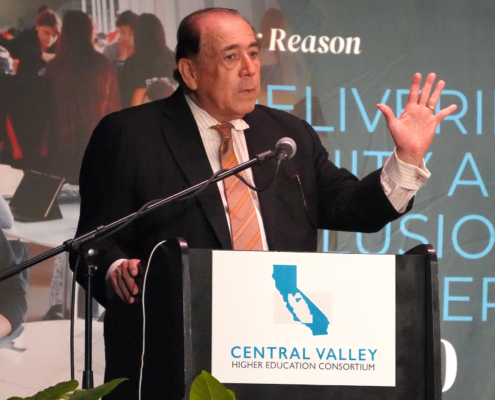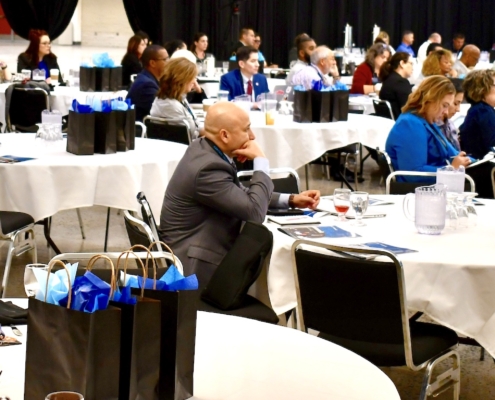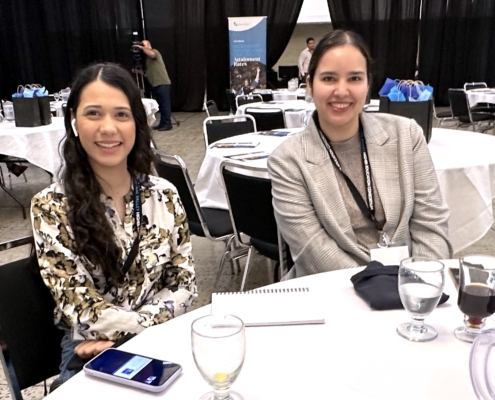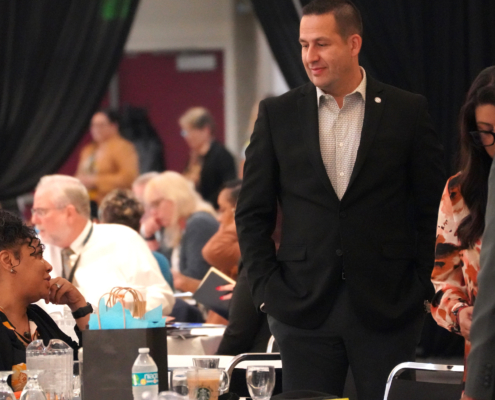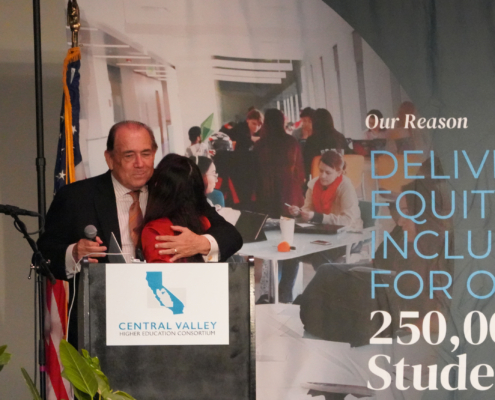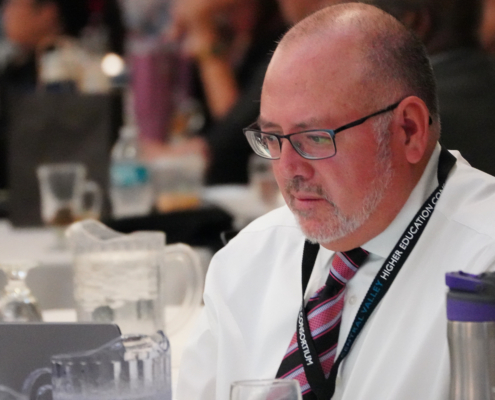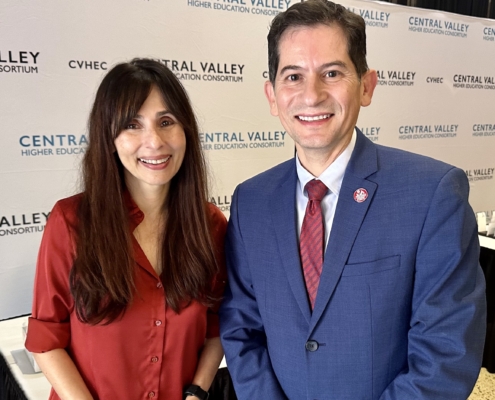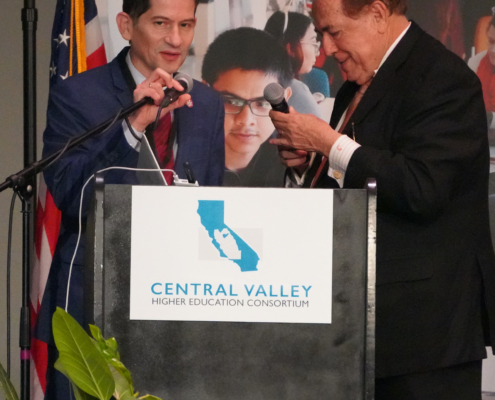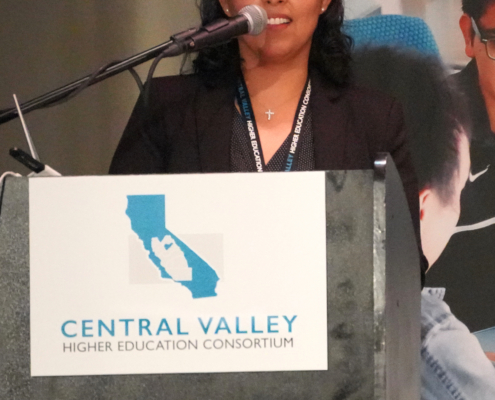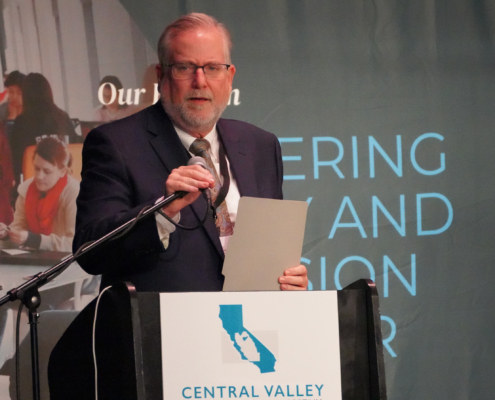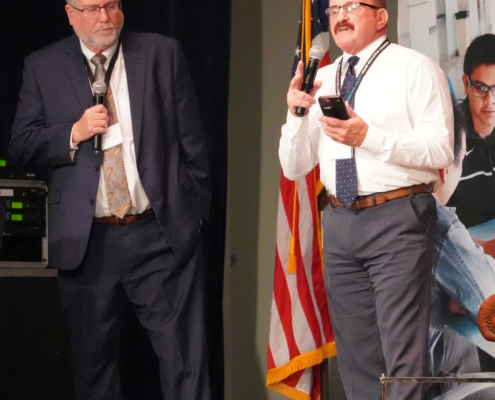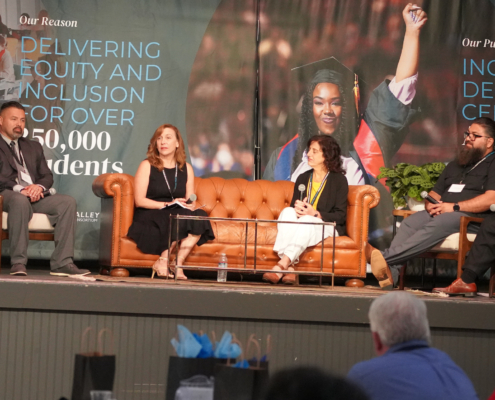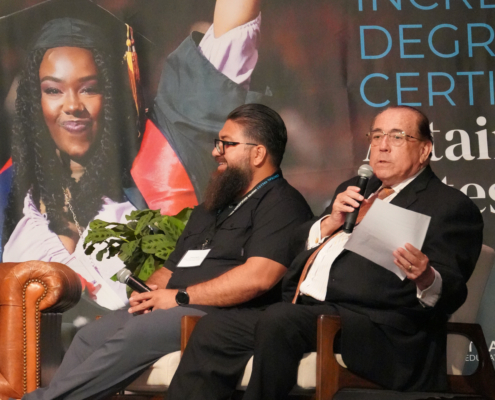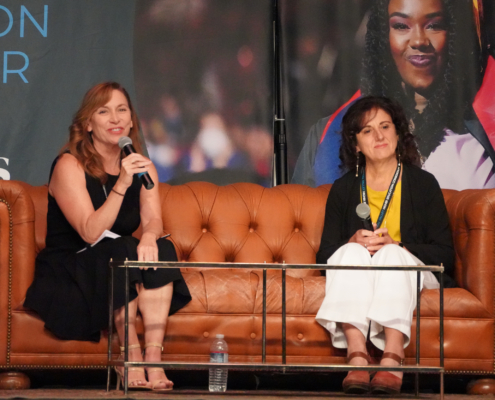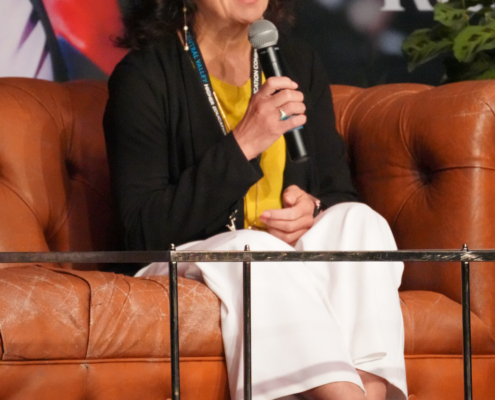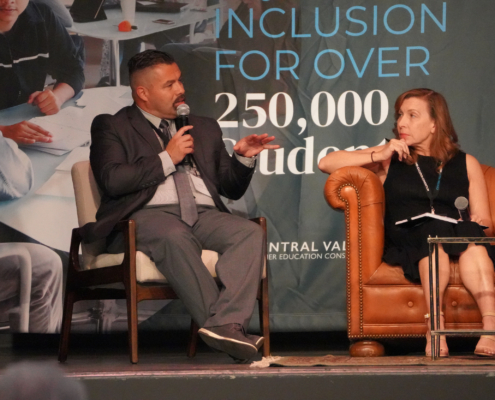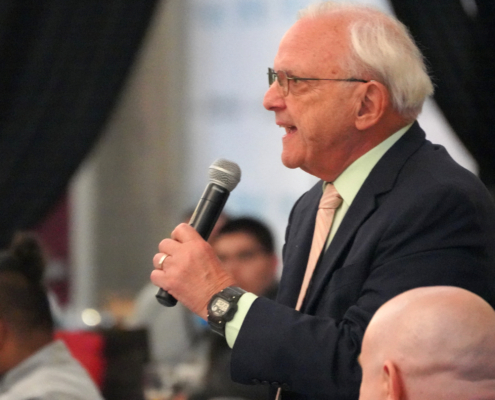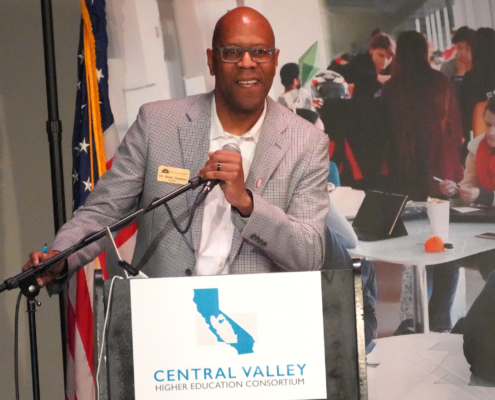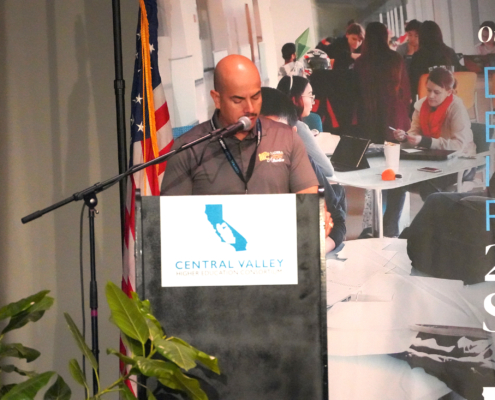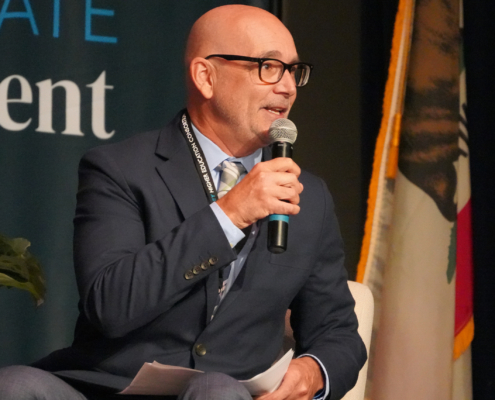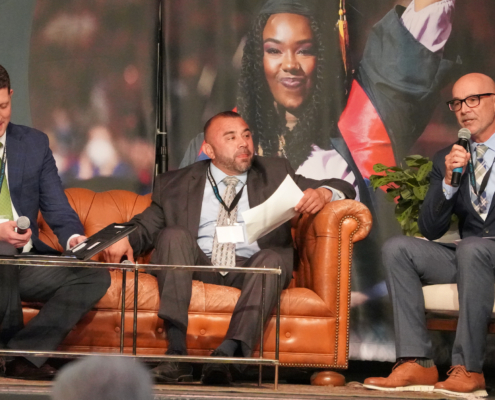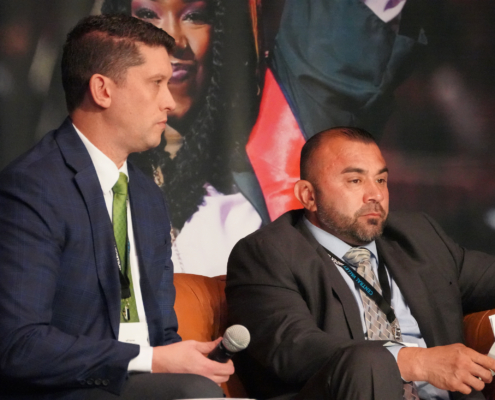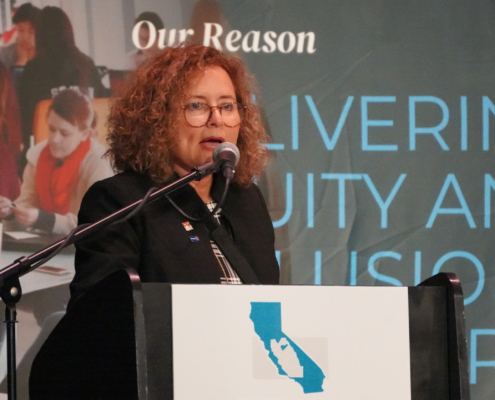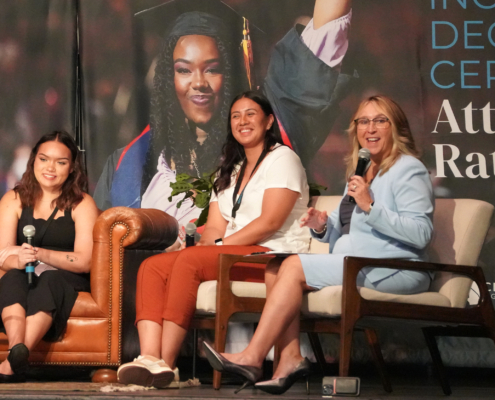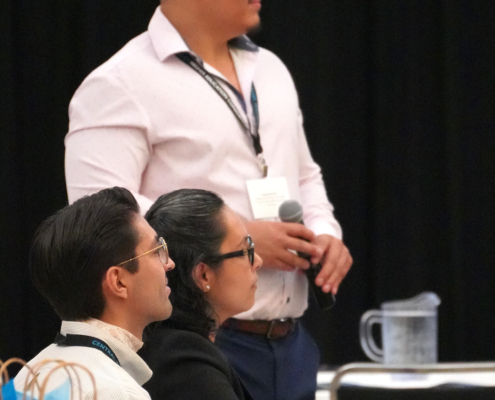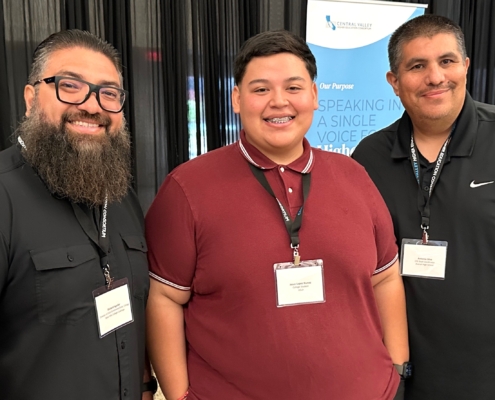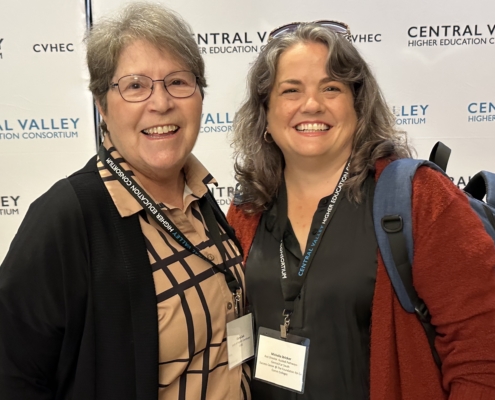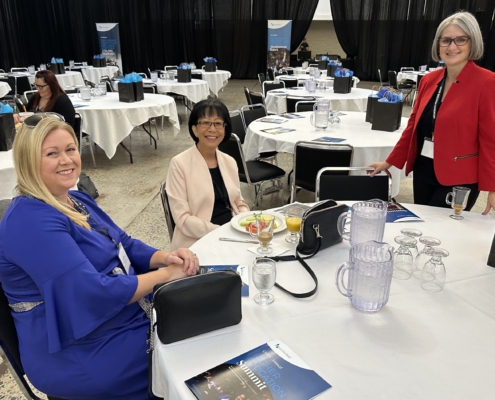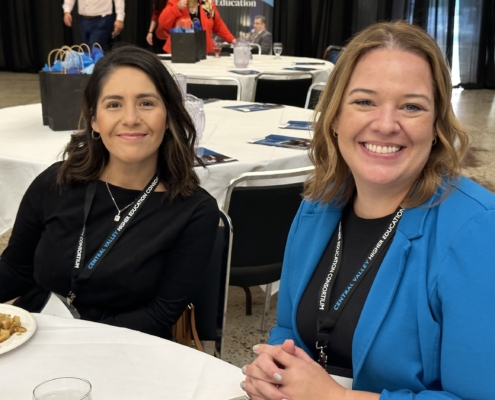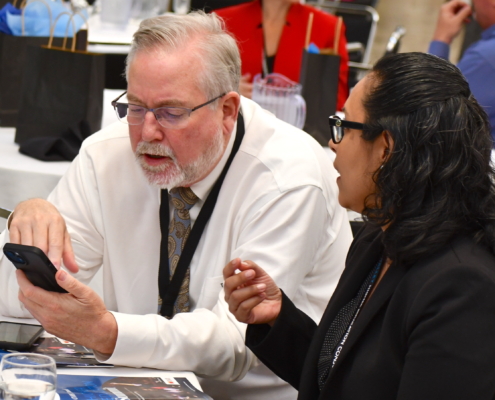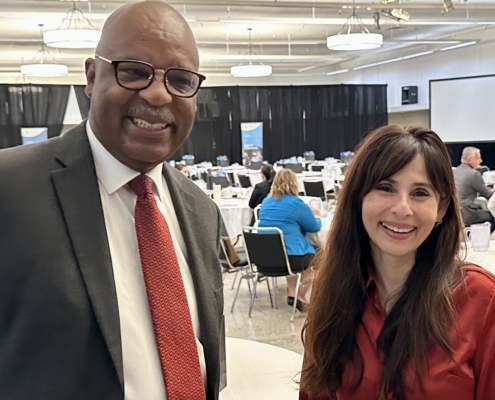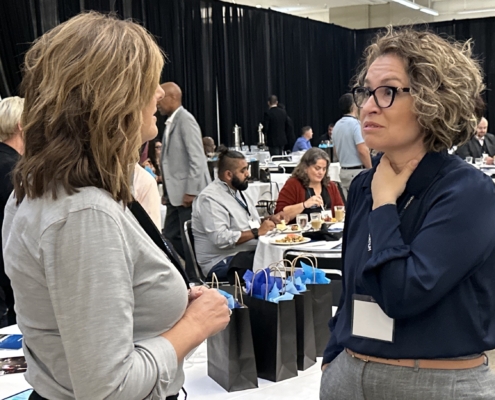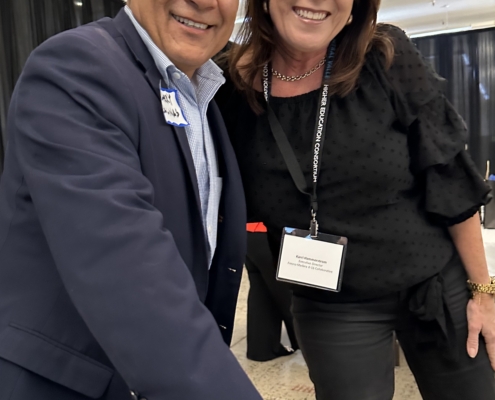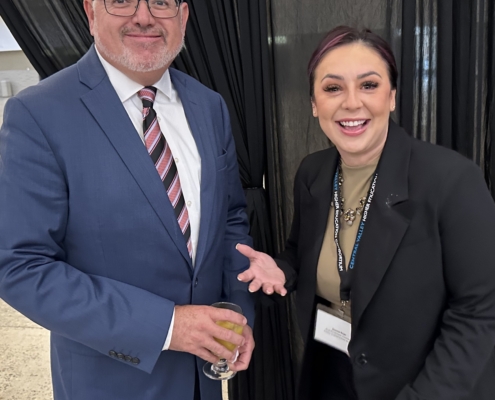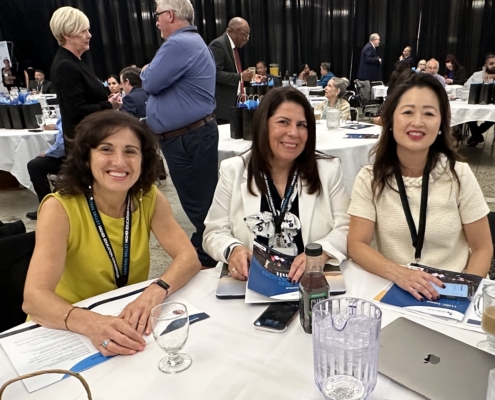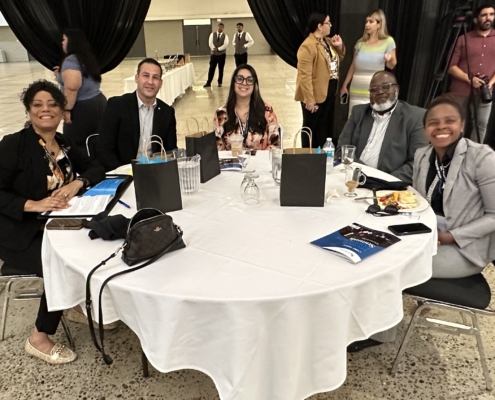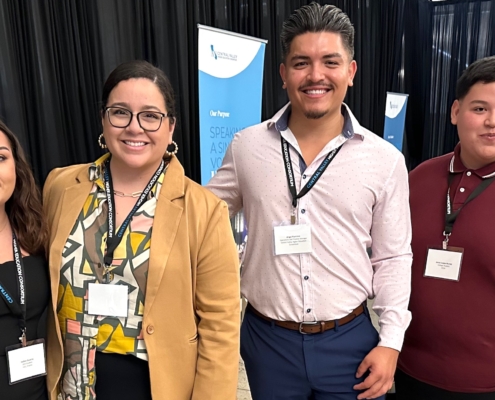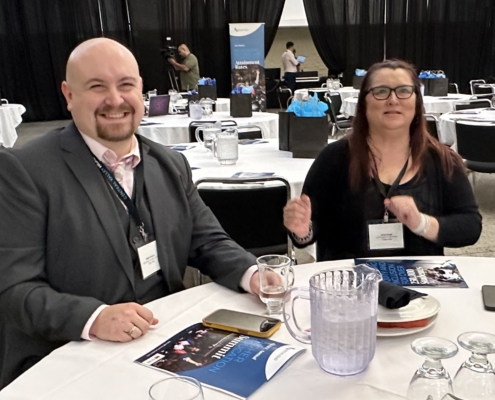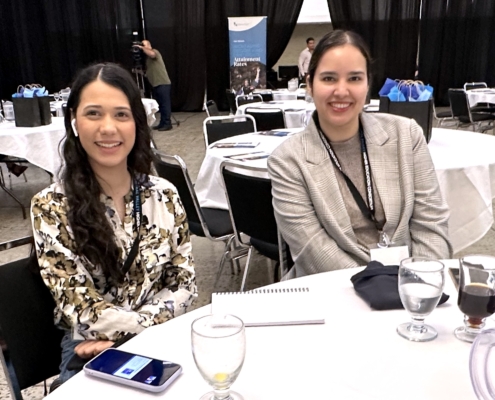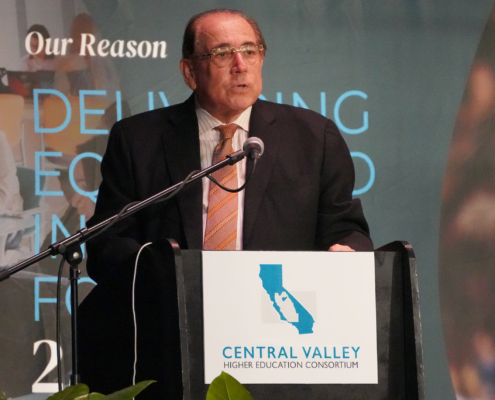MATH TASK FORCE: ‘Something extraordinary’ (Jan. 26 wrap)
Modesto Junior College math professor Tina Akers-Porter discusses her strand group’s deliberations at “The Central Valley Way to AB1705 Success” Convening Jan. 26 where a call for a “principals task force” by Orosi High School Principal Marlena Celaya would bring more secondary education voices to the table.
‘Something extraordinary is happening in math in California’s Central Valley’
Math Task Force latest AB1705 session leads to calls
for more data, high school input, re-convene April 19
BY TOM URIBES
CVHEC Media/Communications Coordinator
Realizing that state guidance surrounding Assembly Bill 1705 remains elusive, valley community college math educators and officials forged ahead at “The Central Valley Way to AB1705 Success” convening Jan. 26 in Fresno with a determined and unified mindset to develop implementation plans that will serve the best interests of their students including a follow-up session set for April.
In addition, the Central Valley Higher Education Consortium (CVHEC) Math Task Force discussion centered around five strands of curriculum planning for implementation before the law goes into effect July 1, two aspects emerged at the lively day-long work session: the increased participation of institutional researchers for pertinent data-collecting and a call for a “principal’s task force” to bring upper secondary education voices to the table.
Presented by CVHEC, the convening — the latest in a series of deliberations since fall — was attended by 82 representatives from the consortium’s 19-member community colleges, one high school principal and campus research professionals.
They agreed to reconvene April 19 for reports on follow-up work that will occur as a result of this most recent event. Registration for that event will open next month with additional details forthcoming.
Facilitated by the Charles A. Dana Center at the University of Texas at Austin, the session last month reviewed five strands of curriculum planning: Validating Prerequisites; Designing Precalculus for 2025; Math Support Outside and Inside the Classroom; Building an AB 1705 Campus Team; and Guided Self-Placement.
“With tensions high and little guidance surrounding AB1705, the 19 community colleges and districts that comprise the CVHEC nine-county region are rolling up their sleeves and getting to work on this math movement the ‘Central Valley Way’,” summarized Tammi Perez-Rice of the Dana Center.
Perez-Rice, who co-facilitated the event, said the convening was solely dedicated to working and planning at a regional and institutional level in two parts. The first part was dedicated to expanding the five work groups that emerged from the Nov. 17 webinar and creating a plan to move forward. The second half of the convening was devoted to institutional planning.
“The fruits produced from these convenings are already being felt around the region,” Perez-Rice said. “The plans and implementations emerging from these convenings are more than just a response to AB705 and AB1705; they cultivate systemic reforms that will benefit all students in the CVHEC region and beyond.”
John Spevak, CVHEC regional coordinator who oversees the consortium’s Math Task Force and co-facilitator of the Jan. 26 gathering, said in the short-term, the five strands work groups will continue to communicate and provide updates in preparation for the April 19 convening. The strand leads are preparing summaries of their Jan. 26 breakout discussions and member college teams are preparing summaries of the tentative plans they developed in the afternoon breakout sessions for oral reports in April.
“In the longer term, our Math Task Force will continue to monitor what the California Community College Chancellor’s Office says, while mainly going forward with our own Central Valley approach to the five strands.”
That “Central Valley Way” stems from the work undertaken by the CVHEC Math task Force, first formed in 2019, in the past year that was intensified with four work sessions beginning Oct. 6 in a virtual convening with CCC vice-chancellor Eric Cooper. The first in-person session followed Oct. 13 in Fresno and another virtual session was held in two parts Nov. 17 before the Jan. 26 session.
These sessions may represent the only concerted effort by a region’s community college math community actively meeting to collaborate across campus boundaries for ways to unite as one voice and determine a curriculum course of action that meets the law’s intent, Spevak said.
“We at CVHEC, along with the Dana Center representatives and our College Bridge partners in the Math Bridge Program, feel that something extraordinary is happening in math in the Central Valley of California,” Spevak said.
After the Jan. 26 session ended, Perez-Rice reiterated a point she made the first time she visited Fresno for the first in-person convening last fall:
“This collaboration today was amazing. As I travel and talk to math faculty all over the country, what I see pulsating from the CVHEC community here in Central California is just compassion; caring about their students; putting their students first; understanding what their students need; and more importantly collaborating with each other working across institutions to make things happen.”
Inviting secondary ed voices to ‘align syllabi’
A key development of the convening was the assertion and agreement that a crucial next step is “to involve high schools in the discussion and determine how to breakdown barriers between systems for a cohesive collaborative effort to put students first across the state of California,” a message delivered by Marlena Celaya, principal of Orosi High School who was the only secondary education official in attendance.
Celaya’s comments, first in a strand session and later in general comments before the assembled group, resonated with the community college professionals as she offered to lead a task force of principals/administrators who would unify with the CVHEC community college math educators for implementation strategy — to listen and hear what the needs are and how to meet those needs.
“I’m willing to lead this work because I don’t want people to go through the wars I went through teaching algebra and volunteering all my time,” said Celaya, a former math teacher at Dinuba High School. “We would want to hear from community colleges and say to them ‘what do you need?’
“We heard something from you today: ‘I want to know what courses are offered at the high school and what does that course description look like?’ Aligning syllabi is what I’d like to do,” Celaya said. “Mathematics is my passion.”
Perez-Rice said the April 19 convening promises more high school representation, with over twelve principals who are part of the Math Bridge Program by CVHEC and College Bridge being invited. Other secondary education officials from throughout the valley are welcome she said.
Participant feedback: ‘great to see we’re not alone in this …’
After the event, several participants shared their assessment of the Jan. 26 convening.
“The conversations were amazing and we really appreciated being here,” said Joshua Lewis, chair of the Bakersfield College Mathematics Dept.
“There have been so many legislative changes and so many unknowns it’s nice to see the work that other campuses are doing and realize that we’re not alone, that we have shared values; that we have shared emphasis on student learning and really care about doing right by all of our students,” he added.
Nathan Cahoon, Taft college math professor, felt that the efforts of CVHEC’s Math Task Force as exhibited at the convening is strengthening the voice of the valley’s math community which will have an impact.
“It was amazing to work with incredible professionals who have some really amazing ideas,” he said. “I know I took many good notes about ideas to implement at our college. The connections we are building here with each other will be powerful down the road as we build a cohesive effort to get some good research together that we can send to the state as one voice from all the colleges.”
Modesto Junior College math professor Marina Hernandez said coming together within the region is relished because when attending other statewide or national conferences, the focus is not as localized.
“It was very helpful to learn what other colleges in the Central Valley are doing because we share similar student population and resources characteristics and their best practices are applicable to us here in our region,” Hernandez said.
Tina Akers-Porter, Modesto Junior College math professor, said the Math Task Force work has helped her better understand what AB1705 is and what it means for her students.
“I feel like I have a better understanding of some of the challenges of the legislation and what others are worried about,” she said. “We share some of those worries but it’s great to hear different points of view on that. A byproduct of this is we are seeing how we need to support underprepared students more, inside and outside the classroom, and sharing ideas to do that.”
Shelly Getty, Taft college math faculty and a strand leader, echoed Akers-Porter: “We left knowing we are going to start some specific tutoring and targeting students for tutoring. We will try to advertise it better and recruit so students get more access to the services we already provide which will greatly impact them. We shared some good ideas on how to do that effectively.”
Marissa Martinez, Taft college math professor, said, “We have our work cut out for us. There’s a lot of things that we have to address with a lot of moving parts. Everything keeps changing but it was great to be able to see that we’re not alone in this, that we’re working together to better serve our students.”
She said this intercollegial collaboration and the feedback from the colleges helps “so we don’t have to reinvent the wheel — what worked, what didn’t work.”
Next steps? Data research
“I would say the next step is collecting our data to see how the numbers show where we are so we can prove that these courses are important for our student success,” Martinez said.
This data aspect was also a key part of the convening as institutional research professionals were invited and directly participated such as Arooj Rizvi, research analyst in the Office of Institutional research and Effectiveness at San Joaquin Delta College.
“Researchers have a monumental role in the implementation of AB 1705 because policymakers are going to depend a lot on what we are able to produce as a group or even as an institution,” Rizvi said. “Being a part of these conversations helps us to see the bigger picture, the context and the requirements of what exactly it is that we are looking for in the data.”
She said it was exciting to hear at the convening what area colleges are going through.
“I realized how similar our challenges are from institution to institution, “she said. “Working through that together and being solution-oriented is something that’s going to take all of us towards a beneficial direction. Seeing us all here today was a defining moment in history.”
Owynn Lancaster, vice president of academic strategy for CVHEC partner College Bridge, said the event was “a huge success seeing folks come together from math to talk about math and really pool their resources to address actual challenges.
“The most powerful focus of change in education is always the educator,” Lancaster said. “I know everything’s heaped on them but in a lot of ways they have the greatest power of the greatest agency for this.”
For more info: centralvalleyhec@gmail.com
For CVHEC media inquiries: Tom Uribes – cvheccommunications@mail.fresnostate.edu (or text 559.348.3278).
See also:
https://bit.ly/MTFconveneKSEE24
Valley’s math ed experts unite to address AB 1705 challenge for student success
The CVHEC Way to Math Success — Implementing AB1705
Math Task Force begins discussion of AB1705 implementation – Nov. 17 next
CVHEC Math Task Force meets in-person Oct. 13 for AB 1705 follow-up
NEWS RELEASE – CVHEC Math Task Force: Impactful legislation (AB 1705) Convenings Oct. 6 & 13
CVHEC Website Feature: Math Task Force Page
PHOTO GALLERY
Central Valley Transfer Project: valley’s four-year colleges collaborating
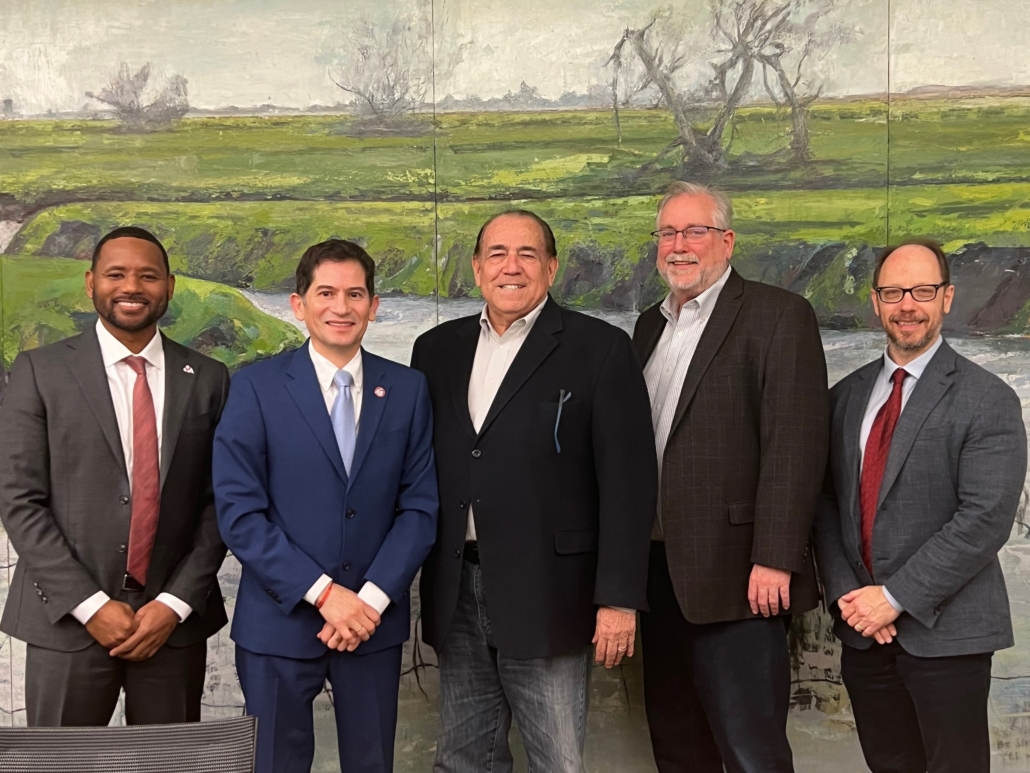
Fresno State, a founding CVHEC member, joined CVHEC’s historic Central Valley Transfer Project in January with (from left): Dr. Kent Willis, vice president of Fresno State Student Affairs and Enrollment Management; University President Saúl Jiménez-Sandoval; Dr. Benjamin Duran, CVHEC executive director; Tom Burke, CVHEC regional coordinator; and Dr. Sergio La Porta, associate dean of the Fresno State College of Arts and Humanities.
Fresno State joins in transfer ‘centerpiece’ with
11 CVHEC community colleges, 3 CSUs, UCMerced
The Central Valley Transfer Project is now partnered with the region’s three California State University campuses after Fresno State signed on in January joining Bakersfield and Stanislaus in the historic Central Valley Higher Education Consortium initiative designed to open new doors for students’ successful transfer from community college.
Along with founding partner University of California, Merced, this means the valley’s four public institutions of higher education are working in unison with 8 community colleges currently through CVHEC’s project using the groundbreaking Program Pathways Mapper software. The project has also gained the full support of the California Community College Chancellor’s Office.
The community colleges already in the CVTP, with several more expected to sign on this year, are: Bakersfield College, Clovis Community College, Madera Community College, Merced College, Porterville College, Reedley College, West Hills College-Coalinga and West Hills College-Lemoore.
The Transfer Project is also expanding participation in the north end of the Central Valley with Modesto Junior College, Columbia College and San Joaquin Delta College scheduled to begin onboard this spring for a total of 11 community college partners said Stan Carrizosa, CVHEC regional coordinator and consortium lead for the project.
All Transfer Project partners are members of the consortium with their respective chancellors and presidents serving on the CVHEC Board of Directors.
“The Transfer Project is now a centerpiece for students to both enter and transfer from community college to their four-year universities,” said Dr. Benjamín Durán, CVHEC executive director. “We are excited to share this latest progress of the project which has been featured statewide and nationally at conferences such as the Community College League of California and Complete College America.”
He added, “This innovative approach is the only one in the state that includes a University of California campus collaborating with partner California State University and community colleges in establishing transfer pathways for Central Valley students to get them to and through college in a timely manner.”
Dr. Saúl Jiménez-Sandoval, Fresno State president and CVHEC board member, said, “I’m proud that Fresno State will be a dynamic partner in the Central Valley Transfer Project, as this pathway will empower community college students to become visionary Bulldogs.”
The Fresno State agreement was finalized Jan. 17 between Durán and President Jiménez-Sandoval, with Tom Burke, CVHEC regional coordinator and Transfer Project team member; Dr. Kent Willis, vice president of Enrollment Services; and Dr. Sergio LaPorta, associate dean of the College of Arts and Humanities.
At CVHEC’s Higher Education Summit last fall, CCC Chancellor Sonya Christian announced that the statewide system has designated the Transfer Project as a demonstration project as set forth in her Vision 2030 for all California community colleges. The Transfer Project’s participating community colleges are serving as the pilot campuses with plans to implement statewide.
Carrizosa said the state budget continues to support and fund the onboarding costs for all community colleges to subscribe to the Program Pathways Mapper.
Established in 2021 with UC Merced, Merced College and Bakersfield College, the project is designed to open new doors for students to successfully transfer from community college with its Program Pathways Mapper, Carrizosa said.
He said the Program Pathways Mapper — a public facing, internet-based app that can be downloaded and accessed by the public software platform — provides unprecedented ease of access for students, counselors, advisors and parents much more so than other existing platforms.
“There are no typical requirements for access to PPM such as other internal college systems like Degree Works, Assist.Org and the CSU Transfer Planner,” he said. “These are all course tracking systems but in order to use them, students need to be successfully enrolled in college and have a student email address or other form of login to try and plan. Through PPM students simply upload the public PPM app to their devices and have immediate access.”
Carrizosa said the PPM helps simplify the transfer planning process which can be the most difficult task for many students.
“In much of our Central Valley region, as many as seven out of 10 incoming college freshmen will be first generation students to attend college,” he said. “Research shows that the most difficult task for them is often the application process itself and completing the required steps for enrollment. Systems like Degree Works and others do nothing to remove this common barrier because these systems cannot be accessed until a student successfully enrolls.”
He explained that a high school student can start the Transfer Project journey as a junior or senior by enrolling in college dual enrollment courses enabling them to complete their transfer level English and Math courses while still in high school. These units roll up with them as they enter community college and track the completion of their lower division requirements for their Associate Degree for Transfer in their chosen major via PPM.
“Students can easily select a community college they wish to attend and a major they want to pursue and the lower division courses required are sequentially laid out for them through the Program Pathways Mapper software.”
In addition, the PPM then links those lower division courses to an upper division institution of the student’s choice and shows a clear sequence of upper division courses needed to complete the degree, Carrizosa added.
“The PPM contains clear and accurate information directly from course catalogues from all participating colleges,” Carrizosa said. “The Central Valley Transfer Project is becoming an alternative continuum of courses to the traditional high school A-G or Career Technical Education continuums and is unprecedented in the state’s community college system. We call it ‘The Central Valley Way!’”
“Through the use of PPM, students complete exactly what is required of them to successfully transfer to their four-year university and they follow PPM through their last two years to degree/certificate completion,” Carrizosa said.
Baseline data results also demonstrate the promise that PPM delivers in the Transfer Project.
In a sample of 5,000 incoming freshmen to Bakersfield College in 2022 the students using the PPM increased their “percentage of on-path course completion” to over 80 percent which also closed the equity gap in this statistic for ethnic minority students when compared to their white counterparts, Carrizosa said.
“The same sample showed students using the PPM reduced the ‘number of units-to-degree’ from an average of 87 down to 67,” he added.
The project is now gearing up to expand the partnership with the College Bridge Math Project and to onboard community colleges from the northern region of the Central Valley.
For more information about the CVTP, contact Carrizosa at centralvalleyhec@gmail.com.
CVHEC media inquiries: Tom Uribes – cvheccommunications@mail.fresnostate.edu or text 559.348.3278.
Fresno State media inquiries: PIO Lisa Bell – lbell@csufresno.edu.
See:
· Pilot CVHEC/UC Merced Transfer Project improves process for students
· CVHEC Web Site Feature: Transfer Project
· Historic Transfer Project spurs statewide movement to increase transfer rates
· HIGHER ED NEWS: College Bridge to expand Math Bridge; CVHEC Transfer Project
• A-G
MEMBER NEWS: WHCCD gets federal grant for RuBICON – rural broadband
$1 million USDA grant awarded to West Hills CCD
for broadband cooperative formation
Project director recruitment underway
The West Hills Community College District (WHCCD) has received a $1 million federal grant that will play a pivotal role in establishing the Rural Broadband Initiative Cooperative Network (RuBICON), a project aimed at providing affordable broadband services to rural communities and farms in the Central Valley.
The district, a Central Valley Higher Education Consortium (CVHEC) institution member, announced the United States Department of Agriculture (USDA) award Feb. 21 as well as a search for a project director for RuBICON, which aims to empower local communities by forming a cooperative that delivers reliable and cost-effective broadband access, bridging the digital divide in the rural Central Valley.
The district said this groundbreaking endeavor draws inspiration from the historic electric co-op movement, envisioning equitable change and progress for rural America in the 21st century.
Jeff Seed, WHCCD associate vice chancellor of Information Technology, emphasized the broader impact of this grant, stating, “This is not just about broadband access – it’s about fostering sustainable farming, building robust local economies, and empowering our rural communities for the digital future.”
In a social media post, Chancellor Kristen Clark, who is also CVHEC Board of Directors chair, said, “Excited about this opportunity for the West Hills Community College District to help support high-speed broadband on the Westside of the Central Valley.”
Project RuBICON has garnered support from a diverse coalition of partners committed to assessing and delivering connectivity to rural communities in the Central Valley. The initiative will collect comprehensive data to understand current needs and identify solutions to address connectivity gaps. In addition to infrastructure development, West Hills will offer digital literacy education for local communities and leverage its Farm of the Future to create a framework for agricultural technologists, propelling the community toward Agriculture 4.0.
“This project is designed to facilitate cost-effective broadband deployment, with the goal of serving as a model that can be replicated across the country,” Seed added.
For WHCCD media inquiries, contact Amber Myrick at 559.934.2132 or ambermyrick@whccd.edu.
See:
WHAT THE CV-HEC IS HAPPENING BLOG (January 2024): CVHEC 2023 — surging forward for Central Valley students
To kick off our 2024 “What the CV-HEC is Happening” Blogs, CVHEC Regional Coordinator Stan Carrizosa, Sr. follows up the year-in-review published in our December newsletter issue by offering a perspective of the consortium’s progress in 2023 that sets the stage for a productive new year. Carrizosa, who is president-emeritus of CVHEC member College of the Sequoias and an integral part of the CVHEC team, serves as the lead for the consortium’s Central Valley Transfer Project. The CVHEC blog features perspectives about the higher education community and issues. Submissions are welcome for consideration: Tom Uribes, cvheccommunications@mail.fresnostate.edu.
Propelling successfully, purposefully like a guided rocket
BY STAN A. CARRIZOSA, SR.
CVHEC Regional Coordinator
(President-emeritus, College of the Sequoias)
As a child, I remember watching a weekly science show called “The Undersea World of Jacques Cousteau” that explored the ocean and marine biology.
One fascinating episode depicted how an octopus at any moment could be moving wildly with all eight legs and not advance at all. But once the octopus contracted its core by simultaneously snapping all eight legs in the same direction, a burst of air coming from the fish propelled it successfully and purposefully through the water like a guided rocket.
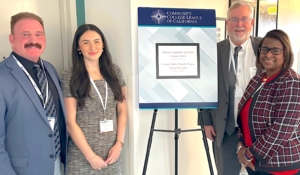
Stan Carrizosa, Sr. (left) and CVHEC Central Valley Transfer Project team partner Tom Burke presented at the Community Colleges League of California in November along with UC Merced grad student Araceli Tilley who discussed her success with the project’s Program Pathway Mapper software and Jennifer Johnson of the Foundation for California Community Colleges (right).
Over the course of the past 12 months, CVHEC has flexed its octopus legs and undertaken otherwise separate projects like Math Bridge and Master’s Upskilling (dual enrollment) and the Central Valley Transfer Project. By aligning them and their sub-parts, CVHEC has achieved the snapping of its octopus legs successfully surging us forward in the form of real achievement results for higher education in the Central Valley and for our region’s students specifically.
As we move into 2024, the work of CVHEC continues to be more aligned in ways that leverage each element and make the wholistic effort more cohesive and successful. This reminds me how effective it was to do this same thing as a college president. It was important to have clear goals and objectives and planned actions designed to address specific aspects of an issue to ensure greater success.
This past year, CVHEC acted like an organization with big-picture goals for improving student achievement region-wide and a measured plan of actions all designed to work together as a system to achieve success.
The two key drivers of this system for CVHEC success are strong intersegmental partnership commitments to:
- a robust dual enrollment;
- increasing successful community college transfers to higher education institutions.
Biggest DE challenge: qualified instructors
Armed with direct feedback from our first Dual Enrollment Summit held three years ago, we heard that one of the biggest challenges to implementing dual enrollment courses was the ability to find qualified instructors to teach college courses on high school campuses.
CVHEC responded by creating an upskilling project where high school teachers in math and English could earn a master’s degree in their content areas and be qualified to apply for and teach dual enrollment college courses on their high school campuses.
Early results from dual enrollment courses showed that students were more successful when the teacher for their college courses was a member of their regular high school faculty. Under the leadership of Dr. John Spevak, CVHEC regional coordinator and vice-president emeritus of Merced College, who facilitated an impressive package offering high school teachers the opportunity to earn a MA degree in their content areas through our partner universities, this opportunity had many residual benefits such as:
- improving the quality of teaching for their high school classes,
- earning higher salaries at their high school,
- creating a professional learning community between high school and community college teachers,
- and most importantly, changing teacher attitudes about the ability for high school students to succeed in college-level work.
The benefits for high school students are enormous.
Those enrolled in college dual enrollment courses experience pass rates of 80-plus percent while mainstream college students pass rates are in the 50 percent range. Finally, dual enrollment has proven to be a game-changer for first-generation college students in closing the equity gap among them and their college prep peers.
If students are able to take their college math and English courses before graduating high school, they start their college career on a level playing field by having completed their first required courses in transfer-level math and English. This enables them to get on the right pathway and stay straight toward their degree completion.
Incentivizing the efforts to increase transfers
The second key driver for CVHEC in 2023 and moving into the new year is the Central Valley Transfer Project!
The breakthrough moment in this project came when UC Merced agreed to review the CSU ADTs and approve these lower-division sequences as meeting the requirements for successful transfer to UCM. Central Valley CSU’s including Bakersfield and Stanislaus have bought in to the Transfer Project as well. Over the past three years CVHEC has worked to complete implementation in eight of our CV community colleges with three more joining the project this year.
Again the student benefit stands clear: early results show that students in the Transfer Project increase their percentages of on-path course completion each semester by 20 points to 80-plus percent. The same students also reduce their number of units to degree from a high of 85 down to 62.
Meanwhile the new statewide Student Funding Formula starts to provide enhanced per/FTES revenue for successful transfers to four-year institutions, further incentivizing the efforts to increase transfers.
We know that of all the successful graduates earning degrees from CSU’s, 50 percent started their education at a community college. Most recently, California Community Colleges Chancellor Dr. Sonya Christian unveiled her VISION 2030 which includes the Central Valley Transfer Project as a Demonstration Project for the entire state. As a result, CVHEC is now being recruited in both southern and northern California to share the success of the CV Transfer Project with those regions through presentations at various convenings.
Thoughtful and effective continuum creating unprecedented leverage for success
In summary, in addition to tracking and assessing our efforts as individual projects, it is equally if not more important to step back and see the bigger picture in the CVHEC body of work for 2023 that sets the stage for promising 2024. We can see there is a thoughtful and effective continuum that links these efforts together creating unprecedented leverage for success:
- CVHEC started by looking at the data and listening to the practitioners in the field to develop an agenda of work to support our colleges.
- Dual enrollment shows great promise but needs more qualified instructors.
- High school students in dual enrollment courses can close the equity gap between them and their peers thus advancing their personal confidence and capacity to succeed in college.
- Most higher ed students start in our community colleges and now through the Transfer Project they have a clear pathway of courses to take for a successful transfer to four-year universities.
- Once our community college students successfully complete their transfer, statistics show that they represent 50 percent of all university graduates.
So, looking back over the past 12 months, CVHEC – like the octopus snapping our legs to successfully surge forward – has successfully linked together major initiatives to build upon and strengthen each other allowing students to experience a continuum of effectiveness and success in achieving their higher education goals and objectives. To close out 2023 and look ahead, our executive director Dr. Benjamín Durán sums up the CVHEC spirit best in his newsletter director’s message published in our December issue:
“This year we are happy to salute and greet our K-12 partner districts who have joined us in creating meaningful pathways from middle school and high school to college. As we prepare to welcome 2024, stay tuned as we continue to nurture many roads leading to one destination – getting students to and through college in a timely manner!”
HIGHER ED NEWS: CCLC, Talent Hub and CCA national convenings
CVHEC and the national/state perspective: industry and
education working off the same playbook
At two national conferences this month and one state convening last month, the Central Valley Higher Education Consortium team reconnected with partners in pursuit of mutual aims: the Community Colleges League of California Annual Convention Nov. 16-18 in Indian Wells, Calif., the Talent Hubs and National Talent Network Annual Convening, Dec. 4-7 in Mobile Alabama and the Complete College America 2023 Annual Convening: Future Ready Dec. 10-12 in Las Vegas, Nevada.
“These dynamic convenings of nation higher education and community leaders signaled that we are back, post-covid, speaking in a single voice on higher ed policy issues that affect our region with the goal of increasing Central Valley degree and certificate attainment rates,” said Dr. Benjamín Durán, CVHEC executive director.
“These three events provided us the opportunity to fulfill CVHEC’s role as a unified voice for higher education issues in the Central Valley on a broader state and national scale.”
Dr. Durán led a CVHEC contingency of Ángel Ramírez, finance and operation manager, and Elaine Cash, grants and programs coordinator, beginning with the Talent Hubs convening presented by CivicLab with sponsor Lumina Foundation.
At Talent Hub, presented by the CivicLab, the CVHEC reps joined colleagues from throughout the nation in revisiting how partnerships between industry and education, working off the same playbook, are vital to cross-collaboration success for both landscapes.
Fresno was first designated as a Talent Hub by Lumina in 2017 with CVHEC selected as a representative because of the consortium’s work to dramatically impact valley degree attainment, retention and persistence rates specifically among Hispanic, African American and low-income populations by utilizing remediation reform with co-requisite models for both English and math to increase college-level course completion.
Dr. Durán said key themes of the CivicLab convening reinforced the need for and value of cross sector collaboration for career pathways by the members of the Talent Hub nationwide.
“Nobody knows the future, but if industry and education work off the same playbook we will be in a better position,” Dr. Durán said, echoing messages from the opening session. “That’s why partnerships between the two are so important.”
Since the initial Lumina funding, CVHEC has utilized annual grant renewals to achieve its goals in the areas of Dual Enrollment, Transfers, Math Pathways and Open Educational Resources underscored by its annual Central Valley Higher Education Summit.
At the Complete College America conference, participants explored “a clear-eyed vision for leading systems change” in higher education throughout the nation under Martin Luther King Jr.’s 1963 quote, “The fierce urgency of now!”
Specifically, Dr. Duran presented on a CCA breakout session, “Central Valley Community Colleges and UC Merced – Igniting Intersegmental Miracle to Increase Transfers,” with Stan Carrizosa, president-emeritus of College of the Sequoias who is now CVHEC’s regional coordinator and Central Valley Transfer Project lead, and Jennifer Johnson, chief partnership officer for the
Foundation for California Community Colleges.
They discussed the CVTP and how it has been adopted by the California Community Colleges as a demonstration project for the consortium’s nine-county region with the goal to expand systemwide as announced by CCC Chancellor Sonya Christian at the CVHEC Summit held Oct. 20.
Also attending the CCA conference were two CVHEC board members, Dr. Lena Tran, president of Columbia College, who presented on the “Golden State Aspirations – Charting a Path to Equitable College Completion in California,” and Dr. Claudia Habib, president of Porterville College.
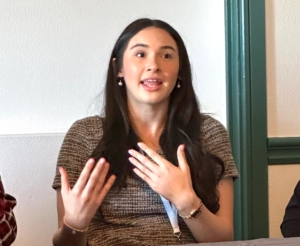 At the CCLC conference last month, the CVHEC Transfer Project once again presented an update on the historic the California Community Colleges demonstration project.
At the CCLC conference last month, the CVHEC Transfer Project once again presented an update on the historic the California Community Colleges demonstration project.
A special CVHEC guest panelist was student Araceli Tilley who testified how the project’s Program Pathway Mapper software is a major tool for self-starting students like herself even beyond first-time admission. Joining her and Carrizosa in CVHEC’s presentation at CLCC were Tom Burke, interim chancellor of the Kern Community College District, and Dr. James Zimmerman, special assistant to the executive vice chancellor and provost for Transfer Initiatives at UC Merced.
MEMBER NEWS: 2023 HEED Award Recipients
CVHEC members Fresno State and UC Merced
honored with 2023 diversity award
Two Central Valley Higher Education Consortium members – Fresno State and the University of California, Merced – are among 108 national recipients of the Higher Education Excellence in Diversity (HEED) Award presented annually by The Insight Into Diversity Magazine recognizing colleges and universities that demonstrate an outstanding commitment to diversity.
The oldest and largest diversity publication in higher education recognized Fresno State for a 10th consecutive year. UC Merced, the most diverse in the University of California system, was praised for its efforts to support and strengthen retention and graduation rates for historically underrepresented and first-generation college students.
The HEED recipients are featured in the November/December 2023 magazine issue. Insight Into Diversity magazine advances best practices in diversity, equity, and inclusion (DEI) in higher education.
Through thought-provoking print and online articles, Insight shares expert advice, valuable resources, in-depth profiles of top DEI programs at colleges and universities and headline news to help keep readers informed and empower them to advance DEI initiatives at their institutions.
Created in 2012 the HEED Award is the only national honor to recognize institutions of higher education for their outstanding commitment to diversity, equity, and inclusion.
Fresno State and Stanislaus State are designated Hispanic Serving Institutions.
For details of each member’s award, see:
CVHEC Summit 2023 wrap: a myriad of takeaways for participants
Porterville College President Claudia Habib (third from left) introduced CVHEC Summit student panelists Hailee Guerra, Araceli Tilley, Jesús López Nuñez, Alondra Veloz and moderator Dr. Carole Goldsmith, chancellor of the State Center Community College District.
Student panelist ‘earns’ a trip to CCLC to share
her transfer experiences statewide
BY TOM URIBES
CVHEC Communications/Media Coordinator
See CVHEC Summit Media Coverage: KVPR Radio and GV Wire. (MORE)
For Araceli Tilley, an alumna of Merced College, the Program Pathway Mapper used by the CVHEC Transfer Project proved to be not only useful for her transfer to UC Merced in fall 2022, it provided her an easy way to map her college courses for her final two years of college at UC Merced that is leading up to graduation in May 2024 with a degree in psychology.
Araceli shared her experiences on the student panel at the Central Valley Higher Education Consortium Summit 2023 held in Fresno Oct. 20 where the breadth and depth of CVHEC activities such as the Transfer Project were showcased. The summit is sponsored by College Futures Foundation.
She was joined by four other students who shared their experiences in activities CVHEC has sponsored and how much their success could be attributed to those initiatives: Hailee Guerra, Araceli Tilley, Jesús López Nuñez and Alondra Veloz.
“The mapper provided a straight path that really helped me out, especially because counseling and advising is super impacted at many colleges and you don’t always get to meet in-person with advisors so it was nice that I was able to self-direct using it,” Araceli said.
“And since I worked at Merced College as an outreach ambassador, I was able to help other students showing them how it works. It’s a very useful tool, especially for students who are self-directed.”
From a major announcement to kick off the day to the student testimonials, the CVHEC Summit Oct. 20 at the Fresno Convention Center accomplished its goal of convening educators and community leaders to continue developing a unified voice for higher ed issues.
“The student panel was a glimpse into the reason why educators dedicate themselves to this profession,” said Dr. Benjamín Durán, CVHEC executive director.
Araceli’s assessment of Program Mapper and how it helped her plan courses throughout college earned her an invitation by Stan Carrizosa, CVHEC regional coordinator who is the lead for the consortium’s Transfer Project, to participate in the presentation his team will make to the Community College League of California Annual Convention Nov. 16 in Indian Wells.
“I’m very excited about going to the Indian Wells conference,” Araceli said. “I didn’t expect to get asked to go to another conference but it’s a great opportunity to voice my experiences as a transfer student and how the Mapper tool helped me.”
But a key highlight of the summit came early in the day as Dr. Sonya Christian, chancellor of the California Community Colleges, returned “home” to deliver the summit keynote.
In presenting on the CCC Vision 2023 strategy plan, she announced the new Central Valley Transfer Pathways Demonstration Project, evolving from CVHEC’s own Transfer Project, to help community college students streamline the transfer process to four-year. (See story).
“As expected, Chancellor Christian’s presentation was inspiring and reflected her commitment to students in the state,” Duran said.
PHOTO GALLERIES for the CVHEC Board of Trustees and Summit Reception (Oct. 19) and
the Central Valley Higher Education Summit (Oct.20)
at the Fresno Convention Center:
What the CV-HEC Is Happening Blog: Math Bridge Update
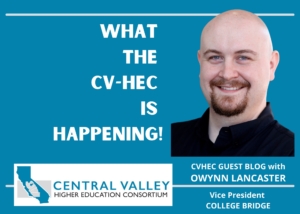 This month’s “What The CV-HEC Is Happening” guest blog is an update of the Math Bridge program presented by Owynn Lancaster, vice president for Academic Strategy with College Bridge, a California non-profit based in Los Angeles County dedicated to forging a path towards both college access and success for underrepresented students. College Bridge is a partner with the Central Valley Higher Education Consortium in the innovative program designed to improve math outcomes for struggling 11th and 12th graders and streamline Math pathways into college. Funded by a five-year $4 million grant through the US Department of Education’s Education Innovation and Research (EIR) Program in January, this ambitious endeavor was kicked off in May with a convening of more than 150 valley K-16 educators in Fresno to begin the onboarding process for this historic intersegmental collaboration between CVHEC member community colleges and high schools in their respective service areas. That initiative was followed in April with a $1.1 million state grant to CVHEC/College Bridge partnership through the Central San Joaquin Valley K-16 Partnership creating the Dual Enrollment (DE) Math Bridge that will provide equitable access to transfer-level math courses with embedded support for high school students who are disproportionately impacted, and/or are not traditionally college-bound. This fall, the College Bridge and CVHEC Math Bridge teams have been visiting campuses to continue the onboard process in preparation for the program’s launch next fall.
This month’s “What The CV-HEC Is Happening” guest blog is an update of the Math Bridge program presented by Owynn Lancaster, vice president for Academic Strategy with College Bridge, a California non-profit based in Los Angeles County dedicated to forging a path towards both college access and success for underrepresented students. College Bridge is a partner with the Central Valley Higher Education Consortium in the innovative program designed to improve math outcomes for struggling 11th and 12th graders and streamline Math pathways into college. Funded by a five-year $4 million grant through the US Department of Education’s Education Innovation and Research (EIR) Program in January, this ambitious endeavor was kicked off in May with a convening of more than 150 valley K-16 educators in Fresno to begin the onboarding process for this historic intersegmental collaboration between CVHEC member community colleges and high schools in their respective service areas. That initiative was followed in April with a $1.1 million state grant to CVHEC/College Bridge partnership through the Central San Joaquin Valley K-16 Partnership creating the Dual Enrollment (DE) Math Bridge that will provide equitable access to transfer-level math courses with embedded support for high school students who are disproportionately impacted, and/or are not traditionally college-bound. This fall, the College Bridge and CVHEC Math Bridge teams have been visiting campuses to continue the onboard process in preparation for the program’s launch next fall.
Expanding the Reach of the
Central Valley Math Bridge
BY OWYNN LANCASTER
College Bridge
After our successful College Orientation meetings in September, the College Bridge team has been darting up and down the San Joaquin Valley, meeting with interested feeder highs schools to onboard and launch them for the coming academic year’s CV Math Bridge Project.
Inspiring our efforts, two amazing CVHEC member colleges have “jumped to lead the pack” as Dr. Lynn Cevallos, our College Bridge president, often says. The first of those with an impressing showing come from Merced College where their team has helped us garner interest from seven possible high schools! Showing the region’s commitment to opening options for their students in math and the impressive connecting power of the college’s administration.
In equally exciting efforts, San Joaquin Delta College helped to secure two committed high school partners from Stockton Unified, with interest from others in their region. Those two Stockton schools, Amos Alonzo Stagg High School and Captain Charles M. Weber of Applied Science and Technology have been two of the smoothest schools to onboard so far! More importantly addition of these schools and the partnership with Delta College now helps us open the CV Math Bridge Project across the breadth of the Valley.
With schools as far north as Stagg High School and as far south as Taft Union High School the reach of this project is now slightly smaller than the state of South Carolina! This means several more flights and drives are still ahead for our College Bridge team to continue to onboard and launch these high school partners, but in the end, we are excited by this transformative work.
The CV Math Bridge’s first cohort of schools will be starting in the coming academic year, 2024-2025, and there’s still room for more in the second cohort starting in academic year, 2025-2026. We invite high schools interested in participating to reach out and contact me at Owynn.Lancaster@college-bridge.org.
Also see: https://bit.ly/CVHECblog1223-GiftOfMath

